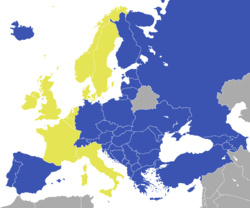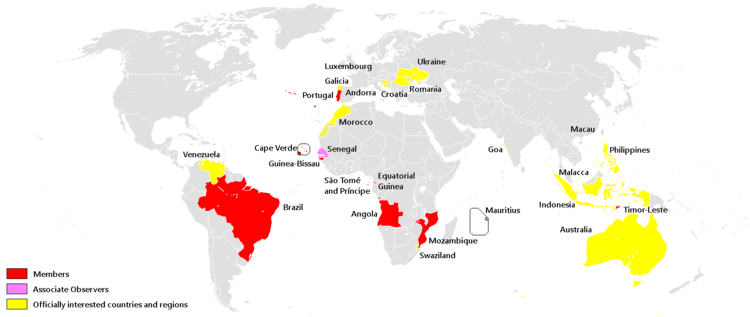Portugal
| Portuguese Republic República Portuguesa[note 1] |
||||||
|---|---|---|---|---|---|---|
|
||||||
| Anthem: "A Portuguesa" "The Portuguese" |
||||||
 Location of Portugal (dark green) – in Europe (green & dark grey) |
||||||
| Capital and largest city | Lisbon 38°46′N 9°9′W / 38.767°N 9.150°W | |||||
| Official languages | Portuguese | |||||
| Recognised regional languages | Mirandese[a] | |||||
| Ethnic groups (2011) |
|
|||||
| Demonym | Portuguese | |||||
| Government | Unitary semi-presidential republic | |||||
| • | President | Marcelo Rebelo de Sousa | ||||
| • | Assembly President | Eduardo Ferro Rodrigues | ||||
| • | Prime Minister | António Costa | ||||
| Legislature | Assembly of the Republic | |||||
| Formation | ||||||
| • | Foundation | 868 | ||||
| • | Re-founding | 1095 | ||||
| • | Sovereignty | 24 June 1128 | ||||
| • | Kingdom | 26 July 1139 | ||||
| • | Recognition | 5 October 1143 | ||||
| • | Papal recognition | 23 May 1179 | ||||
| • | Restoration | 1 December 1640 | ||||
| • | Republic | 5 October 1910 | ||||
| • | Democratization | 25 April 1974 | ||||
| • | Present Constitution[b] | 25 April 1976 | ||||
| • | EEC accession | 1 January 1986 | ||||
| Area | ||||||
| • | Total | 92,212[1] km2 (111th) 35,603 sq mi |
||||
| • | Water (%) | 0.5 | ||||
| Population | ||||||
| • | 2015 estimate | 10,341,330[2] (83rd) | ||||
| • | 2011 census | 10,562,178[3] | ||||
| • | Density | 115/km2 (97th) 298/sq mi |
||||
| GDP (PPP) | 2016 estimate | |||||
| • | Total | $296 billion[4] (50th) | ||||
| • | Per capita | $28,476[4] (40th) | ||||
| GDP (nominal) | 2016 estimate | |||||
| • | Total | $204.186 billion[4] (43th) | ||||
| • | Per capita | $19,611[4] (36th) | ||||
| Gini (2013) | medium |
|||||
| HDI (2014) | very high · 43rd |
|||||
| Currency | Euro (€)[c] (EUR) | |||||
| Time zone | WET (UTC) AZOT (UTC−1) |
|||||
| • | Summer (DST) | WEST (UTC+1) AZOST (UTC) |
||||
| Note: Mainland Portugal and Madeira use WET/WEST, the Azores use AZOT/AZOST | ||||||
| Antipodes | New Zealand and Pacific Ocean |
|||||
| Date format | dd/mm/yyyy | |||||
| Drives on the | right | |||||
| Calling code | +351 | |||||
| ISO 3166 code | PT | |||||
| Internet TLD | .pt | |||||
| a. | ^ Mirandese, spoken in some villages of the municipality of Miranda do Douro, was officially recognized in 1999 (Lei n.° 7/99 de 29 de Janeiro),[7] awarding it an official right-of-use.[8] Portuguese Sign Language is also recognized. |
|||||
| b. | ^ Portuguese Constitution adopted in 1976 with several subsequent minor revisions, between 1982 and 2005. | |||||
| c. | ^ Before 2002, the escudo. | |||||
Portugal (Portuguese: [puɾtuˈɣaɫ]), officially the Portuguese Republic (Portuguese: República Portuguesa), is a country on the Iberian Peninsula, in Southwestern Europe. It is the westernmost country of mainland Europe. To the west and south it is bordered by the Atlantic Ocean and to the east and north by Spain. The Portugal–Spain border is 1,214 km (754 mi) long and considered the longest uninterrupted border within the European Union. The republic also includes the Atlantic archipelagos of the Azores and Madeira, both autonomous regions with their own regional governments.
The territory of modern Portugal has been continuously settled, invaded and fought over since prehistoric times. The Pre-Celts, Celts, Phoenicians, Carthaginians and the Romans were followed by the invasions of the Visigothic and the Suebi Germanic peoples. In 711 the Iberian Peninsula was invaded by the Moors and for the following centuries Portugal would be part of Muslim Al Andalus. Portugal was born as a result of the Christian Reconquista, and in 1139, Afonso Henriques was proclaimed King of Portugal, thus firmly establishing Portuguese independence.[9]
In the 15th and 16th centuries, Portugal established the first global empire, becoming one of the world's major economic, political and military powers.[10][11][12] During this time, Portuguese explorers pioneered maritime exploration in the Age of Discovery, notably under royal patronage of Prince Henry the Navigator and King João II, with such notable discoveries as Vasco da Gama's sea route to India (1497–98), the discovery of Brazil (1500), and the reaching of the Cape of Good Hope. Portugal monopolized the spice trade during this time, and the Portuguese Empire expanded with military campaigns led in Asia. But the destruction of Lisbon in a 1755 earthquake, the country's occupation during the Napoleonic Wars, the independence of Brazil (1822), and the Liberal Wars (1828–34), all left Portugal crippled from war and diminished in its world power.[13]
After the 1910 revolution deposed the monarchy, the democratic but unstable Portuguese First Republic was established, later being superseded by the Estado Novo right-wing authoritarian regime. Democracy was restored after the Portuguese Colonial War and the Carnation Revolution in 1974. Shortly after, independence was granted to almost all its overseas territories,[14] marking the end of the longest-lived colonial empire. Portugal has left a profound cultural and architectural influence across the globe and a legacy of over 250 million Portuguese speakers today.
Portugal is a developed country with a high-income advanced economy and a high living standard.[15][16][17] It is the 5th most peaceful country in the world,[18] maintaining a unitary semi-presidential republican form of government.[19][20][21][22][23] It has the 18th highest Social Progress in the world, putting it ahead of other Western European countries like France, Spain and Italy.[24] A founding member of NATO and the Community of Portuguese Language Countries, it is also a member of numerous other international organizations, including the United Nations, the European Union, the eurozone, and OECD.
History
Early history: Pre-Celts and Celts


The early history of Portugal is shared with the rest of the Iberian Peninsula located in South Western Europe. The name of Portugal derives from the joined Romano-Celtic name Portus Cale. The region was settled by Pre-Celts and Celts, giving origin to peoples like the Gallaeci, Lusitanians, Celtici and Cynetes, visited by Phoenicians and Carthaginians, incorporated in the Roman Republic dominions as Lusitania and part of Gallaecia, after 45 BC until 298 AD, settled again by Suebi, Buri, and Visigoths, and conquered by Moors. Other influences include some 5th-century vestiges of Alan settlements, which were found in Alenquer (old Germanic Alankerk, from Alan+kerk; meaning temple of the Alans), Coimbra and Lisbon.[25]
The region of present-day Portugal was inhabited by Neanderthals and then by Homo sapiens, who roamed the border-less region of the northern Iberian peninsula.[26] These were subsistence societies that, although they did not establish prosperous settlements, did establish organized societies. Neolithic Portugal experimented with domestication of herding animals, the raising of some cereal crops and fluvial or marine fishing.[26]
It is believed by some scholars that early in the first millennium BC, several waves of Celts invaded Portugal from Central Europe and inter-married with the local populations, forming different ethnic groups, with many tribes.
Chief among these tribes were the Calaicians or Gallaeci of Northern Portugal, the Lusitanians of central Portugal, the Celtici of Alentejo, and the Cynetes or Conii of the Algarve. Among the lesser tribes or sub-divisions were the Bracari, Coelerni, Equaesi, Grovii, Interamici, Leuni, Luanqui, Limici, Narbasi, Nemetati, Paesuri, Quaquerni, Seurbi, Tamagani, Tapoli, Turduli, Turduli Veteres, Turdulorum Oppida, Turodi, and Zoelae. A few small, semi-permanent, commercial coastal settlements (such as Tavira) were also founded in the Algarve region by Phoenicians-Carthaginians.
Roman Lusitania and Gallaecia
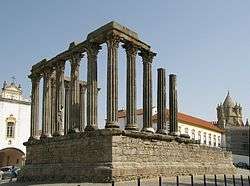
Romans first invaded the Iberian Peninsula in 219 BC. During the last days of Julius Caesar, almost the entire peninsula had been annexed to the Roman Republic. The Carthaginians, Rome's adversary in the Punic Wars, were expelled from their coastal colonies.
The Roman conquest of what is now part of modern-day Portugal took almost two hundred years and took many lives of young soldiers and the lives of those who were sentenced to a certain death in the slavery mines when not sold as slaves to other parts of the empire. It suffered a severe setback in 150 BC, when a rebellion began in the north. The Lusitanians and other native tribes, under the leadership of Viriathus, wrested control of all of western Iberia.
Rome sent numerous legions and its best generals to Lusitania to quell the rebellion, but to no avail—the Lusitanians kept conquering territory. The Roman leaders decided to change their strategy. They bribed Viriathus's allies to kill him. In 139 BC, Viriathus was assassinated, and Tautalus became leader.
Rome installed a colonial regime. The complete Romanization of Lusitania only took place in the Visigothic era.
In 27 BC, Lusitania gained the status of Roman province. Later, a northern province of Lusitania was formed, known as Gallaecia, with capital in Bracara Augusta, today's Braga. There are still many ruins of castros (hill forts) all over modern Portugal and remains of Castro culture. Numerous Roman sites are scattered around present-day Portugal, some urban remains are quite large, like Conímbriga and Mirobriga. The former, beyond being one of the largest Roman settlements in Portugal, is also classified as a National Monument. Conímbriga lies 16 km from Coimbra which by its turn was the ancient Aeminium). The site also has a museum that displays objects found by archaeologists during their excavations.
Several works of engineering, such as baths, temples, bridges, roads, circus, theatres and layman's homes are preserved throughout the country. Coins, some of which coined in Lusitanian land, as well as numerous pieces of ceramics were also found. Contemporary historians include Paulus Orosius (c. 375–418)[27] and Hydatius (c. 400–469), bishop of Aquae Flaviae, who reported on the final years of the Roman rule and arrival of the Germanic tribes.
Germanic kingdoms: Suebi and Visigoths
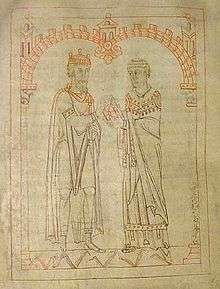
In the early 5th century, Germanic tribes, namely the Suebi and the Vandals (Silingi and Hasdingi) together with their allies, the Sarmatians and Alans invaded the Iberian Peninsula where they would form their kingdom. The Kingdom of the Suebi was the Germanic post-Roman kingdom, established in the former Roman provinces of Gallaecia-Lusitania.
About 410 and during the 6th century it became a formally declared kingdom, where king Hermeric made a peace treaty with the Gallaecians before passing his domains to Rechila, his son. In 448 Réchila died, leaving the state in expansion to Rechiar.
In the year 500, the Visigothic Kingdom was installed in Iberia, centred on Toledo. The Visigoths eventually conquered the Suebi and its capital city Bracara (modern day Portugal's Braga) in 584–585, following the consecutive defeats of the two last Suebi kings Audeca and Malaric. The former Kingdom of the Suebi then became the sixth province of the Visigothic Kingdom of Hispania.
For the next 300 years and by the year 700, the entire Iberian Peninsula was ruled by the Visigoths. This period lasted until 711, when King Roderic (Rodrigo) was killed while opposing a Moorish invasion from the south. From the various Germanic groups who settled in Western Iberia, the Suebi left the strongest lasting cultural legacy in what is today Portugal, Galicia and Asturias.[28][29][30]
Islamic period and the Reconquista

Today's modern day continental Portugal, along with most of modern Spain, was part of the Umayyad Caliphate. This occupation lasted one century in the North (effectively for some decades and later only as a mainly military and administrative claimed region) to approximately four and five centuries in most of the Center and in the South, respectively (711 AD - 1249 AD), following the Umayyad Caliphate conquest of the Iberian Peninsula in 711 AD.
After defeating the Visigoths in only a few months, the Umayyad Caliphate started expanding rapidly in the peninsula. Beginning in 711, the land that is now Portugal became part of the vast Umayyad Caliphate's empire of Damascus, which stretched from the Indus river in the Indian sub-continent (now Pakistan) up to the South of France, until its collapse in 750. That year the west of the empire gained its independence under Abd-ar-Rahman I with the establishment of the Emirate of Córdoba. After almost two centuries, the Emirate became the Caliphate of Córdoba in 929, until its dissolution a century later in 1031 into no less than 23 small kingdoms, called Taifa kingdoms.
The governors of the taifas each proclaimed themselves Emir of their provinces and established diplomatic relations with the Christian kingdoms of the north. Most of Portugal fell into the hands of the Taifa of Badajoz of the Aftasid Dynasty, and after a short spell of an ephemeral Taifa of Lisbon in 1022, fell under the dominion of the Taifa of Seville of the Abbadids poets. The Taifa period ended with the conquest of the Almoravids who came from Morocco in 1086 winning a decisive victory at the Battle of Sagrajas, followed a century later in 1147, after the second period of Taifa, by the Almohads, also from Marrakesh.[31]
Al-Andalus was divided into different districts called Kura. Gharb Al-Andalus at its largest was constituted of ten kuras,[32] each with a distinct capital and governor. The main cities of the period in Portugal were Beja, Silves, Alcácer do Sal, Santarém and Lisbon.
The Muslim population of the region consisted mainly of native Iberian converts to Islam (the so-called Muwallad or Muladi) and berbers. The Arabs were principally noblemen from Oman; and though few in numbers, they constituted the elite of the population. The Berbers were originally from the Atlas mountains and Rif mountains of North Africa and were essentially nomads. The territory which is now Portugal was part of various Muslim states, including the Emirate of Cordoba, the Taifa of Badajoz and the Almohade and Almoravid empires.
County of Portucale
.jpg)
An Asturian Visigothic noble named Pelagius of Asturias in 718 AD was elected leader by many of the ousted Visigoth nobles. Pelagius called for the remnant of the Christian Visigothic armies to rebel against the Moors and regroup in the unconquered northern Asturian highlands, better known today as the Cantabrian Mountains, in what is today the small mountain region in North-western Spain, adjacent to the Bay of Biscay.[33]
Pelagius' plan was to use the Cantabrian mountains as a place of refuge and protection from the invading Moors. He then aimed to regroup the Iberian Peninsula's Christian armies and use the Cantabrian mountains as a springboard from which to regain their lands. In the process, after defeating the Moors in the Battle of Covadonga in 722 AD, Pelagius was proclaimed king, thus founding the Christian Kingdom of Asturias and starting the war of Christian reconquest known in Portuguese as the Reconquista Cristã.[33]
At the end of the 9th century, the region of Portugal, between the rivers Minho and Douro, was freed or reconquered from the Moors by Vimara Peres on the orders of King Alfonso III of Asturias. Finding that the region had previously had two major cities—Portus Cale in the coast and Braga in the interior, with many towns that were now deserted—he decided to repopulate and rebuild them with Portuguese and Galician refugees and other Christians.[34]
Vimara Peres organized the region he freed from the Moors, and elevated it to the status of County, naming it the County of Portugal after the region's major port city—Portus Cale' or modern Porto. One of the first cities Vimara Peres founded at this time is Vimaranes, known today as Guimarães - the "birthplace of the Portuguese nation" or the "cradle city" (Cidade Berço in Portuguese).[34]
After annexing the County of Portugal into one of the several counties that made up the Kingdom of Asturias, King Alfonso III of Asturias knighted Vimara Peres, in 868 AD, as the First Count of Portus Cale (Portugal). The region became known as Portucale, Portugale, and simultaneously Portugália — the County of Portugal.[34]
.png)
Later the Kingdom of Asturias was divided into a number of Christian Kingdoms in Northern Spain due to dynastic divisions of inheritance among the king's offspring. With the forced abdication of Alfonso III "the Great" of Asturias by his sons in 910, the Kingdom of Asturias split into three separate kingdoms of León, Galicia and Asturias. The three kingdoms were eventually reunited in 924 (León and Galicia in 914, Asturias later) under the crown of León.
During the century of internecine struggles for dominance among the Northern Christians kingdoms, the County of Portugal formed the southern portion of the Kingdom of Galicia. At times the Kingdom of Galicia existed independently for short periods, but usually formed an important part of the Kingdom of Leon. Throughout this period, the people of County of Portugal as Galicians found themselves struggling to maintain the autonomy of Galicia with its distinct language and culture (Galician-Portuguese) from the Leonese culture, whenever the status of the Kingdom of Galicia changed in relation to the Kingdom of Leon. As a result of political division, Galician-Portuguese lost its unity when the County of Portugal separated from the Kingdom of Galicia (a dependent kingdom of Leon) to establish the Kingdom of Portugal.
In 1093, Alfonso VI of León and Castile bestowed the county to Henry of Burgundy and married him to his daughter, Teresa of León, for his role in reconquering the land from Moors. Henry based his newly formed county in Bracara Augusta (modern Braga), capital city of the ancient Roman province, and also previous capital of several kingdoms over the first millennia.
Independence and Afonsine era
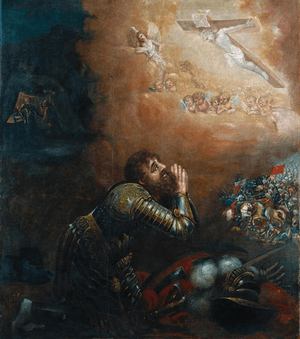
On 24 June 1128, the Battle of São Mamede occurred near Guimarães. Afonso Henriques, Count of Portugal, defeated his mother Countess Teresa and her lover Fernão Peres de Trava, thereby establishing himself as sole leader. Afonso then turned his arms against the Moors in the south.
Afonso's campaigns were successful and, on 25 July 1139, he obtained an overwhelming victory in the Battle of Ourique, and straight after was unanimously proclaimed King of Portugal by his soldiers. This is traditionally taken as the occasion when the County of Portugal, as a fief of the Kingdom of León, was transformed into the independent Kingdom of Portugal
Afonso then established the first of the Portuguese Cortes at Lamego, where he was crowned by the Archbishop of Braga, though the validity of the Cortes of Lamego has been disputed and called a myth created during the Portuguese Restoration War. Afonso was recognized in 1143 by King Alfonso VII of León and Castile, and in 1179 by Pope Alexander III.
During the Reconquista period, Christians reconquered the Iberian Peninsula from Moorish domination. Afonso Henriques and his successors, aided by military monastic orders, pushed southward to drive out the Moors. At this time Portugal covered about half of its present area. In 1249, the Reconquista ended with the capture of the Algarve and complete expulsion of the last Moorish settlements on the southern coast, giving Portugal its present-day borders, with minor exceptions.
In one of these situations of conflict with the kingdom of Castile, Dinis I of Portugal signed with the king Fernando IV of Castile (which was represented, when being a minor, by his mother the queen Maria de Molina) the Treaty of Alcañices (1297), which stipulated that Portugal abolished agreed treaties against the kingdom of Castile for supporting the infant Juan de Castilla. This treaty established inter alia the border demarcation between the kingdom of Portugal and the kingdom of Leon, where the disputed town of Olivenza was included.
The reigns of Dinis I, Afonso IV, and Pedro I for the most part saw peace with the Christian kingdoms of Iberia.
In 1348 and 1349 Portugal, like the rest of Europe, was devastated by the Black Death.[35] In 1373, Portugal made an alliance with England, which is the longest-standing alliance in the world. Over time this went way beyond geo-political and military cooperation (protecting both nations' interests in Africa, the Americas and Asia against French, Spanish and Dutch rivals) and maintained strong trade and cultural ties between the two old European allies. Particularly in the Oporto region, there is visible English influence to this day.
Joanine era and Age of Discoveries

.jpg)
In 1383, John I of Castile, husband of Beatrice of Portugal and son-in-law of Ferdinand I of Portugal, claimed the throne of Portugal. A faction of petty noblemen and commoners, led by John of Aviz (later King John I of Portugal) and commanded by General Nuno Álvares Pereira defeated the Castilians in the Battle of Aljubarrota. With this battle, the House of Aviz became the ruling house of Portugal.
Portugal spearheaded European exploration of the world and the Age of Discovery. Prince Henry the Navigator, son of King João I, became the main sponsor and patron of this endeavour. During this period, Portugal explored the Atlantic Ocean, discovering several Atlantic archipelagos like the Azores, Madeira, and Cape Verde, explored the African coast, colonized selected areas of Africa, discovered an eastern route to India via the Cape of Good Hope, discovered Brazil, explored the Indian Ocean, established trading routes throughout most of southern Asia, and sent the first direct European maritime trade and diplomatic missions to China and Japan.
In 1415, Portugal acquired the first of its overseas colonies by conquering Ceuta, the first prosperous Islamic trade centre in North Africa. There followed the first discoveries in the Atlantic: Madeira and the Azores, which led to the first colonization movements.
Throughout the 15th century, Portuguese explorers sailed the coast of Africa, establishing trading posts for several common types of tradable commodities at the time, ranging from gold to slaves, as they looked for a route to India and its spices, which were coveted in Europe.
The Treaty of Tordesillas, intended to resolve the dispute that had been created following the return of Christopher Columbus, which was made by Pope Alexander VI, the mediator between Portugal and Spain. It was signed on 7 June 1494, and divided the newly discovered lands outside Europe between the two countries along a meridian 370 leagues west of the Cape Verde islands (off the west coast of Africa).
In 1498, Vasco da Gama reached India and brought economic prosperity to Portugal and its population of 1.7 million residents, helping to start the Portuguese Renaissance. In 1500, the Portuguese explorer Gaspar Corte-Real reached what is now Canada and founded the town of Portugal Cove-St. Philip's, Newfoundland and Labrador, long before the French and English in the 17th century, and being just one of many Portuguese Colonizations of the Americas.[36][37][38]
In 1500, Pedro Álvares Cabral discovered Brazil and claimed it for Portugal.[39] Ten years later, Afonso de Albuquerque conquered Goa in India, Muscat and Ormuz in the Persian Strait, and Malacca, now a state in Malaysia. Thus, the Portuguese empire held dominion over commerce in the Indian Ocean and South Atlantic. Portuguese sailors set out to reach Eastern Asia by sailing eastward from Europe, landing in such places as Taiwan, Japan, the island of Timor, and in the Moluccas.
Although for a long period it was believed the Dutch were the first Europeans to arrive in Australia, there is also some evidence that the Portuguese may have discovered Australia in 1521.[40][41][42]
The Treaty of Zaragoza, signed on 22 April 1529 between Portugal and Spain, specified the anti-meridian to the line of demarcation specified in the Treaty of Tordesillas.
All these factors made Portugal one of the world's major economic, military, and political powers from the 15th century until the late 16th century.
Iberian Union, Restoration and early Brigantine era

Portugal's sovereignty was interrupted between 1580 and 1640. This occurred because the last two kings of the House of Aviz – King Sebastian, who died in the battle of Alcácer Quibir in Morocco, and his great-uncle and successor, King Henry of Portugal – both died without heirs, resulting in the Portuguese succession crisis of 1580.
Subsequently, Philip II of Spain claimed the throne and so became Philip I of Portugal. Although Portugal did not lose its formal independence, it was governed by the same monarch who governed the Spanish Empire,[43] briefly forming a union of kingdoms. At this time Spain was a geographic territory.[44] The joining of the two crowns deprived Portugal of an independent foreign policy and led to its involvement in the Eighty Years' War between Spain and the Netherlands.
War led to a deterioration of the relations with Portugal's oldest ally, England, and the loss of Hormuz, a strategic trading post located between Iran and Oman. From 1595 to 1663 the Dutch-Portuguese War primarily involved the Dutch companies invading many Portuguese colonies and commercial interests in Brazil, Africa, India and the Far East, resulting in the loss of the Portuguese Indian sea trade monopoly.

In 1640, John IV spearheaded an uprising backed by disgruntled nobles and was proclaimed king. The Portuguese Restoration War between Portugal and the Spanish Empire, in the aftermath of the 1640 revolt, ended the sixty-year period of the Iberian Union under the House of Habsburg. This was the beginning of the House of Braganza, which reigned in Portugal until 1910.
King John IV's eldest son came to reign as Afonso VI, however his physical and mental disabilities left him overpowered by Luís de Vasconcelos e Sousa, 3rd Count of Castelo Melhor. In a palace coup organized by the King's wife, Maria Francisca of Savoy, and his brother, Pedro, Duke of Beja, King Afonso VI was declared mentally incompetent and exiled first to the Azores and then to the Royal Palace of Sintra, outside Lisbon. After Afonso's death, Pedro came to the throne as King Pedro II. Pedro's reign saw the consolidation of national independence, imperial expansion, and investment in domestic production.
Pedro II's son, John V, saw a reign characterized by the influx of gold into the coffers of the royal treasury, supplied largely by the royal fifth (a tax on precious metals) that was received from the Portuguese colonies of Brazil and Maranhão. Acting as an absolute monarch, John nearly depleted his country's tax revenues on ambitious architectural works, most notably Mafra Palace, and on commissions and additions for his sizable art and literary collections.
Official estimates – and most estimates made so far – place the number of Portuguese migrants to Colonial Brazil during the gold rush of the 18th century at 600,000.[45] This represented one of the largest movements of European populations to their colonies in the Americas during colonial times.
Pombaline era and Enlightenment
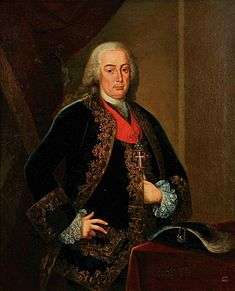
In 1738, Sebastião José de Carvalho e Melo, 1st Marquis of Pombal, began a diplomatic career as the Portuguese Ambassador in London and later in Vienna. The Queen consort of Portugal, Archduchess Maria Anne Josefa of Austria, was fond of Melo; and after his first wife died, she arranged the widowed de Melo's second marriage to the daughter of the Austrian Field Marshal Leopold Josef, Count von Daun. King John V of Portugal, however, was not pleased and recalled Melo to Portugal in 1749. John V died the following year and his son, Joseph I of Portugal, was crowned. In contrast to his father, Joseph I was fond of de Melo, and with the Queen Mother's approval, he appointed Melo as Minister of Foreign Affairs.
As the King's confidence in de Melo increased, the King entrusted him with more control of the state. By 1755, Sebastião de Melo was made Prime Minister. Impressed by British economic success that he had witnessed from the Ambassador, he successfully implemented similar economic policies in Portugal. He abolished slavery in Portugal and in the Portuguese colonies in India; reorganized the army and the navy; restructured the University of Coimbra, and ended discrimination against different Christian sects in Portugal.
But Sebastião de Melo's greatest reforms were economic and financial, with the creation of several companies and guilds to regulate every commercial activity. He demarcated the region for production of Port to ensure the wine's quality, and this was the first attempt to control wine quality and production in Europe. He ruled with a strong hand by imposing strict law upon all classes of Portuguese society from the high nobility to the poorest working class, along with a widespread review of the country's tax system. These reforms gained him enemies in the upper classes, especially among the high nobility, who despised him as a social upstart.
Disaster fell upon Portugal in the morning of 1 November 1755, when Lisbon was struck by a violent earthquake with an estimated Richter scale magnitude of 9. The city was razed to the ground by the earthquake and the subsequent tsunami and ensuing fires.[46] Sebastião de Melo survived by a stroke of luck and then immediately embarked on rebuilding the city, with his famous quote: "What now? We bury the dead and take care of the living."
Despite the calamity and huge death toll, Lisbon suffered no epidemics and within less than one year was already being rebuilt. The new city centre of Lisbon was designed to resist subsequent earthquakes. Architectural models were built for tests, and the effects of an earthquake were simulated by marching troops around the models. The buildings and big squares of the Pombaline City Centre still remain as one of Lisbon's tourist attractions. Sebastião de Melo also made an important contribution to the study of seismology by designing an inquiry that was sent to every parish in the country.
Following the earthquake, Joseph I gave his Prime Minister even more power, and Sebastião de Melo became a powerful, progressive dictator. As his power grew, his enemies increased in number, and bitter disputes with the high nobility became frequent. In 1758 Joseph I was wounded in an attempted assassination. The Távora family and the Duke of Aveiro were implicated and executed after a quick trial. The Jesuits were expelled from the country and their assets confiscated by the crown. Sebastião de Melo prosecuted every person involved, even women and children. This was the final stroke that broke the power of the aristocracy. Joseph I made his loyal minister Count of Oeiras in 1759.
In 1762, Spain invaded Portuguese territory as part of the Seven Years' War, but by 1763 the status quo between Spain and Portugal before the war had been restored.
Following the Távora affair, the new Count of Oeiras knew no opposition. Made "Marquis of Pombal" in 1770, he effectively ruled Portugal until Joseph I's death in 1779. However, historians also argue that Pombal’s "enlightenment," while far-reaching, was primarily a mechanism for enhancing autocracy at the expense of individual liberty and especially an apparatus for crushing opposition, suppressing criticism, and furthering colonial economic exploitation as well as intensifying book censorship and consolidating personal control and profit.[47]
Napoleonic era


The new ruler, Queen Maria I of Portugal, disliked the Marquis because of the power he amassed, and never forgave him for the ruthlessness with which he dispatched the Távora family, and upon her accession to the throne, she withdrew all his political offices. Pombal died on his estate at Pombal in 1782.
In the autumn of 1807, Napoleon moved French troops through Spain to invade Portugal. From 1807 to 1811, British-Portuguese forces would successfully fight against the French invasion of Portugal, while the royal family and the Portuguese nobility, including Maria I, relocated to the Portuguese territory of Brazil, at that time a colony of the Portuguese Empire, in South America. This episode is known as the Transfer of the Portuguese Court to Brazil.
With the occupation by Napoleon, Portugal began a slow but inexorable decline that lasted until the 20th century. This decline was hastened by the independence in 1822 of the country's largest colonial possession, Brazil. In 1807, as Napoleon's army closed in on Lisbon, the Prince Regent João VI of Portugal transferred his court to Brazil and established Rio de Janeiro as the capital of the Portuguese Empire. In 1815, Brazil was declared a Kingdom and the Kingdom of Portugal was united with it, forming a pluricontinental State, the United Kingdom of Portugal, Brazil and the Algarves.
As a result of the change in its status and the arrival of the Portuguese royal family, Brazilian administrative, civic, economical, military, educational, and scientific apparatus were expanded and highly modernized. Portuguese and their allied British troops fought against the French Invasion of Portugal and by 1815 the situation in Europe had cooled down sufficiently that João VI would have been able to return safely to Lisbon. However, the King of Portugal remained in Brazil until the Liberal Revolution of 1820, which started in Porto, demanded his return to Lisbon in 1821.
Thus he returned to Portugal but left his son Pedro in charge of Brazil. When the Portuguese Government attempted the following year to return the Kingdom of Brazil to subordinate status, his son Pedro, with the overwhelming support of the Brazilian elites, declared Brazil's independence from Portugal. Cisplatina (today's sovereign state of Uruguay), in the south, was one of the last additions to the territory of Brazil under Portuguese rule.
Brazilian independence was recognized in 1825, whereby Emperor Pedro I granted unto his father the titular honour of Emperor of Brazil. John VI's death in 1826 caused serious questions in his succession. Though Pedro was his heir, and reigned briefly as Pedro IV, his status as a Brazilian monarch was seen as an impediment to holding the Portuguese throne by both nations. Pedro abdicated in favour of his daughter, Maria II. However, Pedro's brother, Infante Miguel, claimed the throne in protest. After a proposal for Miguel and Maria to marry failed, Miguel seized power as King Miguel I, in 1828. In order to defend his daughter's rights to the throne, Pedro launched the Liberal Wars to reinstall his daughter and establish a constitutional monarchy in Portugal. The war ended in 1834, with Miguel's defeat, the promulgation of a constitution, and the reinstatement of Queen Maria II.
Constitutional monarchy
.jpg)
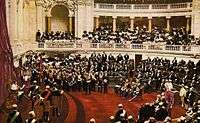

Queen Maria II and King Ferdinand II's son, King Pedro V modernized the country during his short reign (1853-1861). Under his reign, roads, telegraphs, and railways were constructed and improvements in public health advanced. His popularity increased when, during the cholera outbreak of 1853–1856, he visited hospitals handing out gifts and comforting the sick. Pedro's reign was short, as he died of cholera in 1861, after a series of deaths in the royal family, including his two brothers Infante Fernando and Infante João, Duke of Beja, and his wife, Stephanie of Hohenzollern-Sigmaringen. Not having children, his brother, Luís I of Portugal ascended the throne and continued his modernization.
At the height of European colonialism in the 19th century, Portugal had already lost its territory in South America and all but a few bases in Asia. Luanda, Benguela, Bissau, Lourenço Marques, Porto Amboim and the Island of Mozambique were among the oldest Portuguese-founded port cities in its African territories. During this phase, Portuguese colonialism focused on expanding its outposts in Africa into nation-sized territories to compete with other European powers there.
With the Conference of Berlin of 1884, Portuguese Africa territories had their borders formally established on request of Portugal in order to protect the centuries-long Portuguese interests in the continent from rivalries enticed by the Scramble for Africa. Portuguese Africa's cities and towns like Nova Lisboa, Sá da Bandeira, Silva Porto, Malanje, Tete, Vila Junqueiro, Vila Pery and Vila Cabral were founded or redeveloped inland during this period and beyond. New coastal towns like Beira, Moçâmedes, Lobito, João Belo, Nacala and Porto Amélia were also founded. Even before the turn of the 20th century, railway tracks as the Benguela railway in Angola, and the Beira railway in Mozambique, started to be built to link coastal areas and selected inland regions.
Other episodes during this period of the Portuguese presence in Africa include the 1890 British Ultimatum. This forced the Portuguese military to retreat from the land between the Portuguese colonies of Mozambique and Angola (most of present-day Zimbabwe and Zambia), which had been claimed by Portugal and included in its "Pink Map", which clashed with British aspirations to create a Cape to Cairo Railway.
The Portuguese territories in Africa were Cape Verde, São Tomé and Príncipe, Portuguese Guinea, Angola, and Mozambique. The tiny fortress of São João Baptista de Ajudá on the coast of Dahomey, was also under Portuguese rule. In addition, Portugal still ruled the Asian territories of Portuguese India, Portuguese Timor and Macau.
On 1 February 1908, the king Dom Carlos I of Portugal and his heir apparent, Prince Royal Dom Luís Filipe, Duke of Braganza, were murdered in Lisbon. Under his rule, Portugal had twice been declared bankrupt – on 14 June 1892, and again on 10 May 1902 – causing social turmoil, economic disturbances, protests, revolts and criticism of the monarchy. Manuel II of Portugal became the new king, but was eventually overthrown by the 5 October 1910 revolution, which abolished the regime and instated republicanism in Portugal.
First Republic and Estado Novo

Political instability and economic weaknesses were fertile ground for chaos and unrest during the Portuguese First Republic. These conditions would lead to the failed Monarchy of the North, 28 May 1926 coup d'état, and the creation of the National Dictatorship (Ditadura Nacional). This in turn led to the establishment of the right-wing dictatorship of the Estado Novo under António de Oliveira Salazar in 1933.
Portugal was one of only five European countries to remain neutral in World War II. From the 1940s to the 1960s, Portugal was a founding member of NATO, OECD and the European Free Trade Association (EFTA). Gradually, new economic development projects and relocation of mainland Portuguese citizens into the overseas provinces in Africa were initiated, with Angola and Mozambique, as the largest and richest overseas territories, being the main targets of those initiatives. These actions were used to affirm Portugal's status as a transcontinental nation and not as a colonial empire.
After India attained independence in 1947, pro-Indian residents of Dadra and Nagar Haveli, with the support of the Indian government and the help of pro-independence organisations, separated the territories of Dadra and Nagar Haveli from Portuguese rule in 1954.[48] In 1961, São João Baptista de Ajudá's annexation by the Republic of Dahomey was the start of a process that led to the final dissolution of the centuries-old Portuguese Empire.
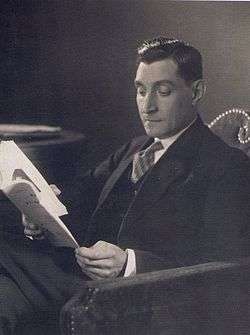
According to the census of 1921 São João Baptista de Ajudá had 5 inhabitants and, at the moment of the ultimatum by the Dahomey Government, it had only 2 inhabitants representing Portuguese Sovereignty.
Another forcible retreat from overseas territories occurred in December 1961 when Portugal refused to relinquish the territories of Goa, Daman and Diu. As a result, the Portuguese army and navy were involved in armed conflict in its colony of Portuguese India against the Indian Armed Forces.
The operations resulted in the defeat and surrender of the limited Portuguese defensive garrison, which was forced to surrender to a much larger military force. The outcome was the loss of the remaining Portuguese territories in the Indian subcontinent. The Portuguese regime refused to recognize Indian sovereignty over the annexed territories, which continued to be represented in Portugal's National Assembly until the military coup of 1974.
Also in the early 1960s, independence movements in the Portuguese overseas provinces of Angola, Mozambique and Guinea in Africa, resulted in the Portuguese Colonial War (1961–1974).
Throughout the colonial war period Portugal had to deal with increasing dissent, arms embargoes and other punitive sanctions imposed by most of the international community. However, the authoritarian and conservative Estado Novo regime, first installed and governed by António de Oliveira Salazar and from 1968 onwards led by Marcelo Caetano, tried to preserve a vast centuries-long intercontinental empire with a total area of 2,168,071 km2.[49]
Carnation Revolution and European integration
The Portuguese government and army resisted the decolonization of its overseas territories until April 1974, when a bloodless left-wing military coup in Lisbon, known as the Carnation Revolution, led the way for the independence of the overseas territories in Africa and Asia, as well as for the restoration of democracy after two years of a transitional period known as PREC (Processo Revolucionário Em Curso). This period was characterized by social turmoil and power disputes between left- and right-wing political forces. The retreat from the overseas territories and the acceptance of its independence terms by Portuguese head representatives for overseas negotiations, which would create independent states in 1975, prompted a mass exodus of Portuguese citizens from Portugal's African territories (mostly from Portuguese Angola and Mozambique).[50][51]
Over one million Portuguese refugees fled the former Portuguese provinces as white settlers were usually not considered part of the new identities of the former Portuguese colonies in Africa and Asia. Mário Soares and António de Almeida Santos were charged with organising the independence of Portugal's overseas territories. By 1975, all the Portuguese African territories were independent and Portugal held its first democratic elections in 50 years.
Portugal continued to be governed by a Junta de Salvação Nacional until the Portuguese legislative election of 1976. It was won by the Portuguese Socialist Party (PS) and Mário Soares, its leader, became Prime Minister of the 1st Constitutional Government on 23 July. Mário Soares would be Prime Minister from 1976 to 1978 and again from 1983 to 1985. In this capacity Soares tried to resume the economic growth and development record that had been achieved before the Carnation Revolution, during the last decade of the previous regime. He initiated the process of accession to the European Economic Community (EEC) by starting accession negotiations as early as 1977.
.jpg)
Portugal bounced between socialism and adherence to the neoliberal model. Land reform and nationalizations were enforced; the Portuguese Constitution (approved in 1976) was rewritten in order to accommodate socialist and communist principles. Until the constitutional revisions of 1982 and 1989, the constitution was a highly charged ideological document with numerous references to socialism, the rights of workers, and the desirability of a socialist economy. Portugal's economic situation after its transition to democracy, obliged the government to pursue International Monetary Fund (IMF)-monitored stabilization programs in 1977–78 and 1983–85.
In 1986, Portugal joined the European Economic Community (EEC) that later became the European Union (EU). In the following years Portugal's economy progressed considerably as a result of EEC/EU structural and cohesion funds and Portuguese companies' easier access to foreign markets.
Portugal's last overseas territory, Macau, was peacefully handed over to the People's Republic of China (PRC) in 1999, under the 1987 joint declaration that set the terms for Macau's handover from Portugal to the PRC. In 2002, the independence of East Timor (Asia) was formally recognized by Portugal, after an incomplete decolonization process that was started in 1975 because of the Carnation Revolution, but interrupted by an Indonesian armed invasion and occupation.
.jpg)
On 26 March 1995, Portugal started to implement Schengen Area rules, eliminating border controls with other Schengen members while simultaneously strengthening border controls with non-member states. In 1996 the country was a co-founder of the Community of Portuguese Language Countries (CPLP) headquartered in Lisbon. Expo '98 took place in Portugal and in 1999 it was one of the founding countries of the euro and the eurozone.
On 5 July 2004, José Manuel Barroso, then Prime Minister of Portugal, was nominated President of the European Commission, the most powerful office in the European Union. On 1 December 2009, the Treaty of Lisbon entered into force, after it had been signed by the European Union member states on 13 December 2007 in the Jerónimos Monastery, in Lisbon, enhancing the efficiency and democratic legitimacy of the Union and improving the coherence of its action.
Economic disruption and an unsustainable growth in borrowing costs in the wake of the late-2000s financial crisis led the country to negotiate in 2011 with the IMF and the European Union, through the European Financial Stability Mechanism (EFSM) and the European Financial Stability Facility (EFSF), a loan to help the country stabilise its finances.
Geography


The territory of Portugal includes an area in the Iberian Peninsula (referred to as the continent by most Portuguese) and two archipelagos in the Atlantic Ocean: the archipelagos of Madeira and the Azores. It lies between latitudes 32° and 43° N, and longitudes 32° and 6° W.
Mainland Portugal is split by its main river, the Tagus that flows from Spain and disgorges in Tagus Estuary, in Lisbon, before escaping into the Atlantic. The northern landscape is mountainous towards the interior with several plateaus indented by river valleys, whereas the south, that includes the Algarve and the Alentejo regions, is characterized by rolling plains.
Portugal's highest peak is the similarly named Mount Pico on the island of Pico in the Azores. This ancient volcano, which measures 2,351 m (7,713 ft) is an iconic symbol of the Azores, while the Serra da Estrela on the mainland (the summit being 1,991 m (6,532 ft) above sea level) is an important seasonal attraction for skiers and winter sports enthusiasts.
The archipelagos of Madeira and the Azores are scattered within the Atlantic Ocean: the Azores straddling the Mid-Atlantic Ridge on a tectonic triple junction, and Madeira along a range formed by in-plate hotspot geology. Geologically, these islands were formed by volcanic and seismic events. The last terrestrial volcanic eruption occurred in 1957–58 (Capelinhos) and minor earthquakes occur sporadically, usually of low intensity.
Portugal's exclusive economic zone, a sea zone over which the Portuguese have special rights over the exploration and use of marine resources, has 1,727,408 km2. This is the 3rd largest exclusive economic zone of the European Union and the 11th largest in the world.
Climate
Portugal is defined as a Mediterranean climate (Csa in the South, interior, and Douro region; Csb in the North, Central Portugal and coastal Alentejo; mixed oceanic climate along the northern half of the coastline[52] and also Semi-arid climate or Steppe climate (BSk in certain parts of Beja district far South) according to the Köppen-Geiger Climate Classification), and is one of the warmest European countries: the annual average temperature in mainland Portugal varies from 8–12 °C (46.4–53.6 °F) in the mountainous interior north to 16–19 °C (60.8–66.2 °F) in the south and on the Guadiana river basin. The Algarve, separated from the Alentejo region by mountains reaching up to 900 metres (3,000 ft) in Alto de Fóia, has a climate similar to that of the southern coastal areas of Spain or Southwest Australia.
Annual average rainfall in the mainland varies from just over 3,200 mm (126.0 in) in the northern mountains to less than 300 mm (11.8 in) in the area of the Massueime River, near Côa, along the Douro river. Mount Pico is recognized as receiving the largest annual rainfall (over 6,250 mm (246.1 in) per year) in Portugal, according to Instituto Português do Mar e da Atmosfera (English: Portuguese Institute of the Sea and the Atmosphere).
In some areas, such as the Guadiana basin, annual average temperatures can be as high as 28 °C (82 °F), and summer highest temperatures routinely are over 40 °C (104 °F). The record high of 47.4 °C (117.3 °F) was recorded in Amareleja, although this might not be the hottest spot in summer, according to satellite readings.[53][54]
Snowfalls occur regularly in the winter in the interior North and Centre of the country in districts such as Vila Real, Bragança, Viseu and Guarda. In winter temperatures may drop below −10.0 °C (14.0 °F) in particular in Serra da Estrela, Serra do Gerês, Serra do Marão and Serra de Montesinho. In these places snow can fall any time from October to May. In the South of the country snowfalls are rare but still occur in the highest elevations. While the official absolute minimum by IPMA is −16.0 °C (3.2 °F) in Penhas da Saúde and Miranda do Douro, lower temperatures have been recorded, such as −17.5 °C (0.5 °F) by Bragança Polytechnic Institute in the outskirts of the city in 1983, and bellow −20.0 °C (−4.0 °F) in Serra da Estrela.
Portugal has around 2500 to 3200 hours of sunshine a year, an average of 4–6 h in winter and 10–12 h in the summer, with higher values in the south-east and lower in the north-west.
The sea surface temperature on the west coast of mainland Portugal varies from 13–15 °C (55.4–59.0 °F) in winter to 18–22 °C (64.4–71.6 °F) in the summer while on the south coast it ranges from 15 °C (59.0 °F) in winter and rises in the summer to about 23 °C (73.4 °F) occasionally reaching 24 °C (75.2 °F).
Both the archipelagos of the Azores and Madeira have a subtropical climate, although variations between islands exist, making weather predictions very difficult (owing to rough topography). The Madeira and Azorean archipelagos have a narrower temperature range, with annual average temperatures exceeding 20 °C (68 °F) along the coast (according to the Portuguese Meteorological Institute). Some islands in Azores do have drier months in the summer. Consequently, the island of the Azores have been identified as having a Mediterranean climate (both Csa and Csb types), while some islands (such as Flores or Corvo) are classified as Maritime Temperate (Cfb) and Humid subtropical (Cfa), respectively, according to Köppen-Geiger classification.
Porto Santo island in Madeira has a semi-arid steppe climate (BSh). The Savage Islands, which are part of the regional territory of Madeira and a nature reserve are unique in being classified as a desert climate (BWh) with an annual average rainfall of approximately 150 mm (5.9 in). The sea surface temperature in the archipelagos varies from 17–18 °C (62.6–64.4 °F) in winter to 24–25 °C (75.2–77.0 °F) in the summer occasionally reaching 26 °C (78.8 °F).
-

Benagil coastal cave, on the Algarve.
-

Sete Cidades volcanic lagoons, on the island of São Miguel.
-
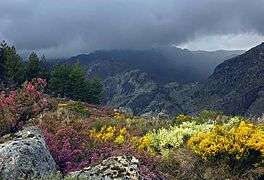
The Serra da Estrela, the highest mountain range on continental Portugal.
-

Snowy winter landscape, near Montalegre.
-

Beach in Vila Nova de Milfontes, on the Alentejo region.
-

The cultivated hillsides of the Douro river valley of Northern Portugal.
-
.jpg)
Pico Island and Mount Pico, the highest mountain in Portugal, seen from São Jorge Island.
-
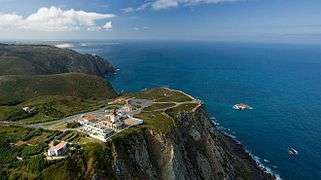
Cabo da Roca, the westernmost point of mainland Europe.
-

View of the mountains in Madeira island.
Biodiversity

Despite the fact that humans have occupied the territory of Portugal for thousands of years, something still remains of the original vegetation. In Gerês both mature deciduous and coniferous forests can be found, an extremely rare worldwide mature Mediterranean forest remain in some parts of the Arrábida mountain and a subtropical laurissilva forest, dating back to the Tertiary period, covers its largest continuous area in the world in the Madeira main island. Due to the human population decrease and rural exodus, Pyrenean oak and other local native trees are colonizing many abandoned areas.
Boar, Iberian red deer, roe deer, and the Iberian wild goat, are reported to have expanded greatly during recent decades. Boars were found recently roaming at night inside large urban areas, like in Setubal. Protected areas of Portugal include one national park (Portuguese: Parque Nacional), 12 natural parks (Portuguese: Parque Natural), nine natural reserves (Portuguese: Reserva Natural), five natural monuments (Portuguese: Monumento Natural), and seven protected landscapes (Portuguese: Paisagem Protegida), which include the Parque Nacional da Peneda-Gerês, the Parque Natural da Serra da Estrela and the Paul d'Arzila.
These natural environments are shaped by diverse flora, and include widespread species of pine (especially the Pinus pinaster and Pinus pinea species), the English oak (Quercus robur), the Pyrenean oak (Quercus pyrenaica) the chestnut (Castanea sativa), the cork-oak (Quercus suber), the holm oak (Quercus ilex) or the Portuguese oak (Quercus faginea). Due to their economic value, some species of the Eucalyptus genus were introduced and are now common, despite their environmental impact.
Laurisilva is a unique type of subtropical rainforest found in few areas of Europe and the world: in the Azores, and in particular on the island of Madeira, there are large forests of endemic Laurisilva forests (the latter protected as a natural heritage preserve). There are several species of diverse mammalian fauna, including the fox, badger, iberian lynx, iberian wolf, wild goat (Capra pyrenaica), wild cat (Felis silvestris), hare, weasel, polecat, chameleon, mongoose, civet, brown bear (spotted near Rio Minho, close to Peneda-Gerês) and many others. Portugal is an important stopover for migratory birds, in places such as Cape St. Vincent or the Monchique mountains, where thousands of birds cross from Europe to Africa during the autumn or in the spring (return migration).
Most of the avian species congregate along the Iberian Peninsula since it is the closest stopover between Northern Europe and Africa. Six hundred bird species occur in Portugal (either for nesting or during the course of migration), and annually there are new registries of nesting species. The archipelagos of the Azores and Madeira are transient stopover for American, European, and African birds, while continental Portugal mostly encounters European and African bird species.
There are more than 100 freshwater fish species, varying from the giant European catfish (in the Tagus International Natural Park) to some small and endemic species that live only in small lakes (along the western portion of country, for example). Some of these rare and specific species are highly endangered because of habitat loss, pollution and drought. Up-welling along the west coast of Portugal makes the sea extremely rich in nutrients and diverse species of marine fish; the Portuguese marine waters are one of the richest in the world. Marine fish species are more common, and include thousands of species, such as the sardine (Sardina pilchardus), tuna and Atlantic mackerel. Bioluminescent species are also well represented (including species in different colour spectrum and forms), like the glowing plankton that are possible to observe in some beaches.
There are many endemic insect species, most only found in certain parts of Portugal, while other species are more widespread like the stag beetle (Lucanus cervus) and the cicada. The Macaronesian islands (Azores and Madeira) have many endemic species (like birds, reptiles, bats, insects, snails and slugs) that evolved independently from other regions of Portugal. In Madeira, for example, it is possible to observe more than 250 species of land gastropods.
Government and administration
Portugal has been a semi-presidential representative democratic republic since the ratification of the Constitution of 1976, with Lisbon, the nation's largest city, as its capital. The Constitution grants the division or separation of powers among four bodies referred as "organs of Sovereignty": the President of the Republic, the Government, the Assembly of the Republic and the Courts.[19]
The President, who is elected to a five-year term, has an executive role: the current President is Marcelo Rebelo de Sousa. The Assembly of the Republic is a single chamber parliament composed of 230 deputies elected for a four-year term. The Government is headed by the Prime Minister (currently António Costa) and includes Ministers and Secretaries of State. The Courts are organized into several levels, among the judicial, administrative and fiscal branches. The Supreme Courts are institutions of last resort/appeal. A thirteen-member Constitutional Court oversees the constitutionality of the laws.
Portugal operates a multi-party system of competitive legislatures/local administrative governments at the national, regional and local levels. The Assembly of the Republic, Regional Assemblies and local municipalities and parishes, are dominated by two political parties, the Socialist Party and the Social Democratic Party, in addition to the Unitary Democratic Coalition (Portuguese Communist Party and Ecologist Party "The Greens"), the Left Bloc and the Democratic and Social Centre – People's Party, which garner between 5 and 15% of the vote regularly.
Presidency of the Republic
.jpg)
The Head of State of Portugal is the President of the Republic, elected to a five-year term by direct, universal suffrage. He or she has also supervision and reserve powers. Presidential powers include the appointment of the Prime Minister and the other members of the Government (where the President takes into account the results of legislative elections); dismissing the Prime Minister; dissolving the Assembly of the Republic (to call early elections); vetoing legislation (which may be overridden by the Assembly); and declaring a state of war or siege. The President is also the ex officio Commander-in-Chief of the Armed Forces.
The President is advised on issues of importance by the Council of State, which is composed of six senior civilian officers, any former Presidents elected under the 1976 Constitution, five-members chosen by the Assembly, and five selected by the president.
Government
.jpg)
The Government is headed by the presidentially appointed Prime Minister, also including (may have one or more Deputy Prime Ministers), Ministers, Secretaries of State and Under-Secretaries of State.
The Government is both the organ of sovereignty that conducts the general politics of the country and the superior body of the public administration.
It has essentially Executive powers, but has also limited Legislative powers. The Government can legislate about its own organization, about areas covered by legislative authorizations conceded by the Assembly of the Republic and about the specific regulation of generalist laws issued by the Assembly.
The Council of Ministers – under the presidency of the Prime Minister (or the President of Portugal at the latter's request) and the Ministers (may also include one or more Deputy Prime Ministers) – acts as the cabinet. Each government is required to define the broad outline of its policies in a programme, and present it to the Assembly for a mandatory period of debate. The failure of the Assembly to reject the government programme by an absolute majority of deputies confirms the cabinet in office.
Parliament
.jpg)
The Assembly of the Republic is the national parliament of Portugal. It is the main Legislative body, although the Government also has limited legislative powers.
The Assembly of the Republic is a unicameral body composed of up to 230 deputies. Elected by universal suffrage according to a system of proportional representation, deputies serve four-year terms of office, unless the President dissolves the Assembly and calls for new elections.
Currently the Government (PS) and its unofficial coalition (BE, PCP, PEV) controls parliament with the most seats. The PSD and CDS-PP form the opposition to the government alongside a single seat held by the PAN.
Law and criminal justice
%2C_Metro_Centric%2C_2015%2C_24025730286.jpg)
The Portuguese legal system is part of the civil law legal system, also called the continental family legal system. The main laws include the Constitution (1976, as amended), the Portuguese Civil Code (1966, as amended) and the Penal Code of Portugal (1982, as amended). Other relevant laws are the Commercial Code (1888, as amended) and the Civil Procedure Code (1961, as amended).
The supreme national courts are the Supreme Court of Justice and the Constitutional Court. The Public Ministry, headed by the Attorney General of the Republic, constitutes the independent body of public prosecutors.
Portuguese law applied in the former colonies and territories and continues to be the major influence for those countries.
Portugal was one of the first countries in the world to abolish the death penalty. Maximum jail sentences are limited to 25 years.
Portugal is also known for having decriminalized the usage of all common drugs in 2001, the first country in the world to do so. Portugal decriminalized possession of effectively all drugs that are still illegal in other developed nations including cannabis, cocaine, heroin, and LSD. While possession is legal, trafficking and possession of more than "10 days worth of personal use" are still punishable by jail time and fines. People caught with small amounts of any drug are given the choice to go to a rehab facility, and may refuse treatment without consequences. Despite criticism from other European nations, who stated Portugal's drug consumption would tremendously increase, overall drug use has declined along with the number of HIV infection cases, which had dropped 50 percent by 2009. Drug use among 16- to 18-year-olds also declined, however the use of marijuana rose only slightly among that age group.[55][56][57]
On 31 May 2010, Portugal became the sixth country in Europe and the eighth country in the world to legally recognize same-sex marriage on the national level. The law came into force on 5 June 2010.[58]
Law enforcement
Portugal's main police organizations are the Guarda Nacional Republicana – GNR (National Republican Guard), a gendarmerie; the Polícia de Segurança Pública – PSP (Public Security Police), a civilian police force who work in urban areas; and the Polícia Judiciária – PJ (Judicial Police), a highly specialized criminal investigation police that is overseen by the Public Ministry.
Administrative divisions
Administratively, Portugal is divided into 308 municipalities (Portuguese: municípios or concelhos), which after a reform in 2013 are subdivided into 3,092 civil parishes (Portuguese: freguesia). Operationally, the municipality and civil parish, along with the national government, are the only legally identifiable local administrative units identified by the government of Portugal (for example, cities, towns or villages have no standing in law, although may be used as catchment for the defining services). For statistical purposes the Portuguese government also identifies NUTS, inter-municipal communities and informally, the district system, used until European integration (and being phased-out by the national government). Continental Portugal is agglomerated into 18 districts, while the archipelagos of the Azores and Madeira are governed as autonomous regions; the largest units, established since 1976, are either mainland Portugal (Portuguese: Portugal Continental) and the autonomous regions of Portugal (Azores and Madeira).
The 18 districts of mainland Portugal are: Aveiro, Beja, Braga, Bragança, Castelo Branco, Coimbra, Évora, Faro, Guarda, Leiria, Lisbon, Portalegre, Porto, Santarém, Setúbal, Viana do Castelo, Vila Real and Viseu – each district takes the name of the district capital.
Within the European Union NUTS (Nomenclature of Territorial Units for Statistics) system, Portugal is divided into seven regions: the Azores, Alentejo, Algarve, Centro, Lisboa, Madeira and Norte, and with the exception of the Azores and Madeira, these NUTS areas are subdivided into 28 subregions.
| Districts[59] | ||||||||
|---|---|---|---|---|---|---|---|---|
| District | Area | Population |  |
District | Area | Population | ||
| 1 | Lisbon | 2,761 km2 (1,066 sq mi) | 2,250,533 | 10 | Guarda | 5,518 km2 (2,131 sq mi) | 160,939 | |
| 2 | Leiria | 3,517 km2 (1,358 sq mi) | 470,930 | 11 | Coimbra | 3,947 km2 (1,524 sq mi) | 430,104 | |
| 3 | Santarém | 6,747 km2 (2,605 sq mi) | 453,638 | 12 | Aveiro | 2,808 km2 (1,084 sq mi) | 714,200 | |
| 4 | Setúbal | 5,064 km2 (1,955 sq mi) | 851,258 | 13 | Viseu | 5,007 km2 (1,933 sq mi) | 377,653 | |
| 5 | Beja | 10,225 km2 (3,948 sq mi) | 152,758 | 14 | Bragança | 6,608 km2 (2,551 sq mi) | 136,252 | |
| 6 | Faro | 4,960 km2 (1,915 sq mi) | 451,006 | 15 | Vila Real | 4,328 km2 (1,671 sq mi) | 206,661 | |
| 7 | Évora | 7,393 km2 (2,854 sq mi) | 166,706 | 16 | Porto | 2,395 km2 (925 sq mi) | 1,817,117 | |
| 8 | Portalegre | 6,065 km2 (2,342 sq mi) | 118,506 | 17 | Braga | 2,673 km2 (1,032 sq mi) | 848,185 | |
| 9 | Castelo Branco | 6,675 km2 (2,577 sq mi) | 196,264 | 18 | Viana do Castelo | 2,255 km2 (871 sq mi) | 244,836 | |
| Autonomous Regions | ||
|---|---|---|
| Autonomous Region | Area | Population |
| |
2,333 km2 (901 sq mi) | 246,772 |
| |
801 km2 (309 sq mi) | 267,785 |
Foreign relations
.jpg)
A member state of the United Nations since 1955, Portugal is also a founding member of NATO (1949), OECD (1961) and EFTA (1960); it left the latter in 1986 to join the European Economic Community, which became the European Union in 1993. In 1996 it co-founded the Community of Portuguese Language Countries (CPLP), which seeks to foster closer economic and cultural ties between the world's Lusophone nations.
In addition, Portugal is a full member of the Latin Union (1983) and the Organization of Ibero-American States (1949). It has a friendship alliance and dual citizenship treaty with its former colony, Brazil. Portugal and England (subsequently, the United Kingdom of Great Britain and Northern Ireland) share the world's oldest active military accord through their Anglo-Portuguese Alliance (Treaty of Windsor), which was signed in 1373.
There are two international territorial disputes, both with Spain:
- Olivenza. Under Portuguese sovereignty since 1297, the municipality of Olivenza was ceded to Spain under the Treaty of Badajoz in 1801, after the War of the Oranges. Portugal claimed it back in 1815 under the Treaty of Vienna. However, since the 19th century, it has been continuously ruled by Spain which considers the territory theirs not only de facto but also de jure.
- The Ilhas Selvagens (Savage Islands). The archipelago is under Portuguese domination but is geographically closer to the Canary Islands (165 km) than to Madeira (280 km). Found in 1364 by Italian navigators, the islands belonged to private owners until 1971, when the Portuguese government bought them and established a natural reserve area covering the whole archipelago. The islands have been claimed by Spain since 1911 and the dispute has caused some periods of political tension between the two countries. The main problem is not so much their intrinsic value but the fact that they expand considerably to the south the Exclusive Economic Zone of Portugal.
Military
Portuguese Army Chaimite V-200 |
.jpg) Portuguese Navy MEKO-200 PN |
 Portuguese Air Force F-16 Fighting Falcon |
The armed forces have three branches: Navy, Army and Air Force. They serve primarily as a self-defense force whose mission is to protect the territorial integrity of the country and provide humanitarian assistance and security at home and abroad. As of 2008, the three branches numbered 39,200 active personnel including 7,500 women. Portuguese military expenditure in 2009 was $5.2 billion, representing 2.1 percent of GDP. Military conscription was abolished in 2004. The minimum age for voluntary recruitment is 18 years.
The Army (21,000 personnel) comprises three brigades and other small units. An infantry brigade (mainly equipped with Pandur II APC), a mechanized brigade (mainly equipped with Leopard 2 A6 tanks and M113 APC) and a Rapid Reaction Brigade (consisting of paratroopers, commandos and rangers). The Navy (10,700 personnel, of which 1,580 are marines) has five frigates, seven corvettes, two submarines, and 28 patrol and auxiliary vessels. The Air Force (7,500 personnel) has the Lockheed F-16 Fighting Falcon and the Dassault/Dornier Alpha Jet as the main combat aircraft.
In addition to the three branches of the armed forces, there is the National Republican Guard, a security force subject to military law and organization (gendarmerie) comprising 25,000 personnel. This force is under the authority of both the Defense and the Interior Ministry. It has provided detachments for participation in international operations in Iraq and East Timor.
The United States maintains a military presence with 770 troops in the Lajes Air Base at Terceira Island, in the Azores. The Allied Joint Force Command Lisbon (JFC Lisbon) – one of the three main subdivisions of NATO's Allied Command Operations – it is based in Oeiras, near Lisbon.
In the 20th century, Portugal engaged in two major conflicts: World War I and the Portuguese Colonial War (1961–1974). After the end of the Portuguese Empire in 1975, the Portuguese Armed Forces have participated in peacekeeping missions in East Timor, Bosnia, Kosovo, Afghanistan, Somalia, Iraq (Nasiriyah) and Lebanon. Portugal also conducted several independent unilateral military operations abroad, as were the cases of the interventions of the Portuguese Armed Forces in Angola in 1992 and in Guinea-Bissau in 1998 with the main objectives of protecting and withdrawing of Portuguese and foreign citizens threatened by local civil conflicts.
Government finance
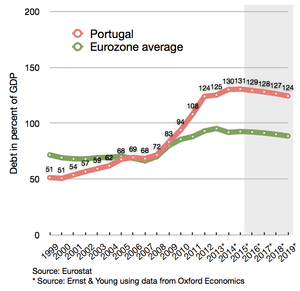
The Portuguese government is heavily indebted, and received a 78 billion euro bailout from the European Union and the International Monetary Fund in May 2011.[60] The ratio of Portugal’s debt to its overall economy, was 107 percent when it received the bailout.[60] As part of the deal, the country agreed to cut its budget deficit from 9.8 percent of GDP in 2010 to 5.9 percent in 2011, 4.5 percent in 2012 and 3 percent in 2013.[61]
After the bailout was announced, the Portuguese government headed by Pedro Passos Coelho managed to implement measures with the intention of improving the state's financial situation, including tax hikes, a freeze of civil service-related lower-wages and cuts of higher-wages by 14.3%, on top of the government's spending cuts. The Portuguese government also agreed to eliminate its golden share in Portugal Telecom which gave it veto power over vital decisions.[62][63] In 2012, all public servants had already seen an average wage cut of 20% relative to their 2010 baseline, with cuts reaching 25% for those earning more than 1,500 euro per month.[64]
The IMF, the European Commission (EC) and the European Central Bank (ECB) said in September 2012 that Portugal’s debt would peak at 124 percent of gross domestic product in 2014.[65] The IMF previously said in July 2012 that Portugal’s debt would peak at about 118.5 percent of GDP in 2013.[65] In September 2013, the Portuguese Government reviewed again the public debt of Portugal for 2013 to 127.8 percent, after a peak of 130.9 percent in that month.[66]
A report released in January 2011 by the Diário de Notícias[67] and published in Portugal by Gradiva, had demonstrated that in the period between the Carnation Revolution in 1974 and 2010, the democratic Portuguese Republic governments encouraged over-expenditure and investment bubbles through unclear Public–private partnerships and funding of numerous ineffective and unnecessary external consultancy and advisory of committees and firms. This allowed considerable slippage in state-managed public works and inflated top management and head officer bonuses and wages. Persistent and lasting recruitment policies boosted the number of redundant public servants. Risky credit, public debt creation, and European structural and cohesion funds were mismanaged across almost four decades.[68]
After the financial crisis of 2007–08, it was known in 2008–2009 that two Portuguese banks (Banco Português de Negócios (BPN) and Banco Privado Português (BPP)) had been accumulating losses for years due to bad investments, embezzlement and accounting fraud. The case of BPN was particularly serious because of its size, market share, and the political implications - Portugal's then current President, Cavaco Silva, and some of his political allies, maintained personal and business relationships with the bank and its CEO, who was eventually charged and arrested for fraud and other crimes.[69][70][71] In the grounds of avoiding a potentially serious financial crisis in the Portuguese economy, the Portuguese government decided to give them a bailout, eventually at a future loss to taxpayers and to the Portuguese people in general.
Economy

Portugal is a developed and a high income country, with its GDP per capita in 2014 being 78% of the EU27 average - increasing from 76% in 2012.[72] The Portuguese currency is the euro (€), which replaced the Portuguese Escudo, and the country was one of the original member states of the eurozone. Portugal's central bank is the Banco de Portugal, an integral part of the European System of Central Banks. Most industries, businesses and financial institutions are concentrated in the Lisbon and Porto metropolitan areas—the Setúbal, Aveiro, Braga, Coimbra and Leiria districts are the biggest economic centres outside these two main areas. According to World Travel Awards, Portugal is the Europe's Leading Golf Destination 2012 and 2013.[73][74]
Since the Carnation Revolution of 1974, which culminated in the end of one of Portugal's most notable phases of economic expansion (that started in the 1960s),[75] a significant change has occurred in the nation's annual economic growth. After the turmoil of the 1974 revolution and the PREC period, Portugal tried to adapt to a changing modern global economy, a process that continues in 2013. Since the 1990s, Portugal's public consumption-based economic development model has been slowly changing to a system that is focused on exports, private investment and the development of the high-tech sector. Consequently, business services have overtaken more traditional industries such as textiles, clothing, footwear and cork (Portugal is the world's leading cork producer),[76] wood products and beverages.[77]
In the second decade of the 21st century the Portuguese economy suffered its most severe recession since the 1970s resulting in the country having to be bailed out by the European Commission, European Central Bank and International Monetary Fund. The bailout, agreed to in 2011, required Portugal to enter into a range of austerity measures in exchange for funding support of €78 billion. In May 2014 the country exited the bailout but reaffirmed its commitment to maintaining its reformist momentum. At the time of exiting the bailout the economy had contracted by 0.7% in the first quarter of 2014, however unemployment, while still high had fallen to 15.3 percent.[78]
The average wage in Portugal is 910 € per month (net), excluding self-employed individuals[79] and the minimum wage, which is regulated/ref by law, is €530 per month (paid 14 times per annum).
The Global Competitiveness Report for 2014-2015, published by the World Economic Forum, placed Portugal on the 36th position on the economic index. This represents a sharp increase from the 51st position where Portugal appeared in 2013-2014.
The Economist Intelligence Unit's quality of life index placed Portugal as the country with the 19th-best quality of life in the world for 2005, ahead of other economically and technologically advanced countries like France, Germany, the United Kingdom and South Korea, but 9 places behind its only neighbour, Spain.[80] This is despite the fact that Portugal remains one of the countries with the lowest per capita GDP in Western Europe.[81]

Major State-owned companies include Águas de Portugal (water), Caixa Geral de Depósitos (banking), Comboios de Portugal (railways), Companhia das Lezírias (agriculture) and RTP (media). Some former state-owned entities are managed by state-run holding company Parpública, which is a shareholder of several public and private companies. Among former State owned companies recently privatized are CTT (postal service), TAP Portugal (airline) and ANA (airports).
Companies listed on Euronext Lisbon stock exchange like EDP, Galp, Jerónimo Martins, Mota-Engil, Novabase, Semapa, Portucel Soporcel, Portugal Telecom and Sonae, are among the largest corporations of Portugal by number of employees, net income or international market share. The Euronext Lisbon is the major stock exchange of Portugal and is part of the NYSE Euronext, the first global stock exchange. The PSI-20 is Portugal's most selective and widely known stock index.
Primary sector

Agriculture in Portugal is based on small to medium-sized family-owned dispersed units. However, the sector also includes larger scale intensive farming export-oriented agrobusinesses backed by companies (like Grupo RAR's Vitacress, Sovena, Lactogal, Vale da Rosa, Companhia das Lezírias and Valouro). The country produces a wide variety of crops and livestock products, including tomatoes, citrus, green vegetables, rice, corn, barley, olives, oilseeds, nuts, cherries, bilberry, table grapes, edible mushrooms, dairy products, poultry and beef.
Forestry has also played an important economic role among the rural communities and industry (namely paper industry that includes Portucel Soporcel Group, engineered wood that includes Sonae Indústria, and furniture that includes several manufacturing plants in and around Paços de Ferreira, the core of Portugal's major industrial operations of IKEA). In 2001, the gross agricultural product accounted for 4 per cent of the national GDP.
Traditionally a sea-power, Portugal has had a strong tradition in the Portuguese fishing sector and is one of the countries with the highest fish consumption per capita.[82] The main landing sites in Portugal (including Azores and Madeira), according to total landings in weight by year, are the harbours of Matosinhos, Peniche, Olhão, Sesimbra, Figueira da Foz, Sines, Portimão and Madeira. Portuguese processed fish products are exported through several companies, under a number of different brands and registered trademarks, such as Ramirez, the world’s oldest active canned fish producer.
Portugal is a significant European minerals producer and is ranked among Europe's leading copper producers. The nation is also a notable producer of tin, tungsten and uranium. However, the country lacks the potential to conduct hydrocarbon exploration and aluminium, a limitation that has hindered the development of Portugal's mining and metallurgy sectors. Although the country has vast iron and coal reserves—mainly in the north—after the 1974 revolution and the consequent economic globalization, low competitiveness forced a decrease in the extraction activity for these minerals. The Panasqueira and Neves-Corvo mines are among the most recognised Portuguese mines that are still in operation.
Secondary sector

Industry is diversified, ranging from automotive (Volkswagen Autoeuropa and Peugeot Citroen), aerospace (Embraer and OGMA), electronics and textiles, to food, chemicals, cement and wood pulp. Volkswagen Group's AutoEuropa motor vehicle assembly plant in Palmela is among the largest foreign direct investment projects in Portugal. Modern non-traditional technology-based industries, such as aerospace, biotechnology and information technology, have been developed in several locations across the country. Alverca, Covilhã,[83] Évora,[84] and Ponte de Sor are the main centres of the Portuguese aerospace industry, which is led by Brazil-based company Embraer and the Portuguese company OGMA. Following the turn of the 21st century, many major biotechnology and information technology industries have been founded, and are concentrated in the metropolitan areas of Lisbon, Porto, Braga, Coimbra and Aveiro.
Tertiary sector
The banking and insurance sectors performed well until the late-2000s financial crisis, and this partly reflected a rapid deepening of the market in Portugal. While sensitive to various types of market and underwriting risks, it has been estimated that overall both the life and non-life sectors will be able to withstand a number of severe shocks, even though the impact on individual insurers varies widely.[85]
Travel and tourism continue to be extremely important for Portugal. It has been necessary for the country to focus upon its niche attractions, such as health, nature and rural tourism, to stay ahead of its competitors.[86]
Portugal is among the 20 most visited countries in the world, receiving an average of 13 million foreign tourists each year.[87] In 2014, Portugal was elected The Best European Country by the USA Today.[88]
Tourist hotspots in Portugal are Lisbon, Algarve, Madeira, Porto and the city of Coimbra. Lisbon attracts the 16th most tourists among European cities[89] (with seven million tourists occupying the city's hotels in 2006).[90]
Also, between 4-5 million religious pilgrims visit Fátima each year, where apparitions of the Blessed Virgin Mary to three shepherd children reportedly took place in 1917. The Sanctuary of Fátima is one of the largest Roman Catholic shrines in the world. The Portuguese government continues to promote and develop new tourist destinations, such as the Douro Valley, the island of Porto Santo, and Alentejo.
The legend of the Rooster of Barcelos tells the story of a dead rooster's miraculous intervention in proving the innocence of a man who had been falsely accused and sentenced to death. The story is associated with the 17th-century calvary that is part of the collection of the Archeological Museum located in Paço dos Condes, a gothic-style palace in Barcelos, a city in northwest Portugal. The Rooster of Barcelos is bought by many tourists as a souvenir.
In November 30th, the United Nations added Portugal Bisalhães tradition of making black pottery to the UNESCO Heritage Protection List.[91]
Quaternary sector


.jpg)
Scientific and technological research activities in Portugal are mainly conducted within a network of R&D units belonging to public universities and state-managed autonomous research institutions like the INETI – Instituto Nacional de Engenharia, Tecnologia e Inovação and the INRB – Instituto Nacional dos Recursos Biológicos. The funding and management of this research system is mainly conducted under the authority of the Ministry of Science, Technology and Higher Education (MCTES) itself and the MCTES's Fundação para a Ciência e Tecnologia (FCT).
The largest R&D units of the public universities by volume of research grants and peer-reviewed publications, include biosciences research institutions like the Instituto de Medicina Molecular, the Centre for Neuroscience and Cell Biology, the IPATIMUP, the Instituto de Biologia Molecular e Celular and the Abel Salazar Biomedical Sciences Institute.
Among the largest non-state-run research institutions in Portugal are the Instituto Gulbenkian de Ciência and the Champalimaud Foundation, a neuroscience and oncology research centre, which in addition awards every year one of the highest monetary prizes of any science prize in the world. A number of both national and multinational high-tech and industrial companies, are also responsible for research and development projects. One of the oldest learned societies of Portugal is the Sciences Academy of Lisbon, founded in 1779.
Iberian bilateral state-supported research efforts include the International Iberian Nanotechnology Laboratory and the Ibercivis distributed computing platform, which are joint research programmes of both Portugal and Spain. Portugal is a member of several pan-European scientific organizations. These include the European Space Agency (ESA), the European Laboratory for Particle Physics (CERN), ITER, and the European Southern Observatory (ESO).
Portugal has the largest aquarium in Europe, the Lisbon Oceanarium, and the Portuguese have several other notable organizations focused on science-related exhibits and divulgation, like the state agency Ciência Viva, a programme of the Portuguese Ministry of Science and Technology to the promotion of a scientific and technological culture among the Portuguese population,[92] the Science Museum of the University of Coimbra, the National Museum of Natural History at the University of Lisbon, and the Visionarium. With the emergence and growth of several science parks throughout the world that helped create many thousands of scientific, technological and knowledge-based businesses, Portugal started to develop several[93] science parks across the country. These include the Taguspark (in Oeiras), the Coimbra iParque (in Coimbra), the biocant (in Cantanhede), the Madeira Tecnopolo[94] (in Funchal), Sines Tecnopolo[95] (in Sines), Tecmaia[96] (in Maia) and Parkurbis[97] (in Covilhã). Companies locate in the Portuguese science parks to take advantage of a variety of services ranging from financial and legal advice through to marketing and technological support.
Egas Moniz, a Portuguese physician who developed the cerebral angiography and leucotomy, received in 1949 the Nobel Prize in Physiology or Medicine – he is the first Portuguese recipient of a Nobel Prize and the only in the sciences.
The European Innovation Scoreboard 2011, placed Portugal-based innovation in the 15th position, with an impressive increase in innovation expenditure and output.[98]
Transport

.jpg)
By the early 1970s Portugal's fast economic growth with increasing consumption and purchase of new automobiles set the priority for improvements in transportation. Again in the 1990s, after joining the European Economic Community, the country built many new motorways. Today, the country has a 68,732 km (42,708 mi) road network, of which almost 3,000 km (1,864 mi) are part of system of 44 motorways. Opened in 1944, the first motorway (which linked Lisbon to the National Stadium) was an innovative project that made Portugal among one of the first countries in the world to establish a motorway (this roadway eventually became the Lisbon-Cascais highway, or A5).
Although a few other tracts were created (around 1960 and 1970), it was only after the beginning of the 1980s that large-scale motorway construction was implemented. In 1972, Brisa, the highway concessionaire, was founded to handle the management of many of the regions motorways. On many highways, toll needs to be paid, see Via Verde. Vasco da Gama bridge is the longest bridge in Europe.[99][100]
Continental Portugal's 89,015 km2 (34,369 sq mi) territory is serviced by four international airports located near the principal cities of Lisbon, Porto, Faro and Beja. Lisbon's geographical position makes it a stopover for many foreign airlines at several airports within the country. The primary flag-carrier is TAP Portugal, although many other domestic airlines provide services within and without the country. The government decided to build a new airport outside Lisbon, in Alcochete, to replace Lisbon Portela Airport, though this plan has been stalled due to austerity measures. Currently, the most important airports are in Lisbon, Porto, Faro, Funchal (Madeira), and Ponta Delgada (Azores), managed by the national airport authority group ANA – Aeroportos de Portugal.
A national railway system that extends throughout the country and into Spain, is supported and administered by Comboios de Portugal. Rail transport of passengers and goods is derived using the 2,791 km (1,734 mi) of railway lines currently in service, of which 1,430 km (889 mi) are electrified and about 900 km (559 mi) allow train speeds greater than 120 km/h (75 mph). The railway network is managed by the REFER while the transport of passengers and goods are the responsibility of Comboios de Portugal (CP), both public companies. In 2006 the CP carried 133 million passengers and 9,750,000 t (9,600,000 long tons; 10,700,000 short tons) of goods.
The major seaports are located in Sines, Lisbon, Leixões, Setúbal, Aveiro, Figueira da Foz, and Faro.
The two largest metropolitan areas have subway systems: Lisbon Metro and Metro Sul do Tejo in the Lisbon Metropolitan Area and Porto Metro in the Porto Metropolitan Area, each with more than 35 km (22 mi) of lines. In Portugal, Lisbon tram services have been supplied by the Companhia de Carris de Ferro de Lisboa (Carris), for over a century. In Porto, a tram network, of which only a tourist line on the shores of the Douro remains, began construction on 12 September 1895 (a first for the Iberian Peninsula). All major cities and towns have their own local urban transport network, as well as taxi services.
Energy
Portugal has considerable resources of wind and river power, the two most cost-effective renewable sources. Since the turn of the 21st century, there has been a trend towards the development of a renewable resource industry and reduction of both consumption and use of fossil fuel resources. In 2006, the world's largest solar power plant at that date, the Moura Photovoltaic Power Station, began operating near Moura, in the south, while the world's first commercial wave power farm, the Aguçadoura Wave Farm, opened in the Norte region (2008). By the end of 2006, 66% of the country's electrical production was from coal and fuel power plants, while 29% were derived from hydroelectric dams, and 6% by wind energy.[101]
In 2008, renewable energy resources were producing 43% of the nation's consumption of electricity, even as hydroelectric production decreased with severe droughts.[102] As of June 2010, electricity exports had outnumbered imports. In the period between January and May 2010, 70% of the national production of energy came from renewable sources.[103]
Portugal’s national energy transmission company, Redes Energéticas Nacionais (REN), uses sophisticated modeling to predict weather, especially wind patterns, and computer programs to calculate energy from the various renewable-energy plants. Before the solar/wind revolution, Portugal had generated electricity from hydropower plants on its rivers for decades. New programs combine wind and water: wind-driven turbines pump water uphill at night, the most blustery period; then the water flows downhill by day, generating electricity, when consumer demand is highest. Portugal’s distribution system is also now a two-way street. Instead of just delivering electricity, it draws electricity from even the smallest generators, like rooftop solar panels. The government aggressively encouraged such contributions by setting a premium price for those who buy rooftop-generated solar electricity.
Demographics
The Statistics Portugal (Portuguese: INE - Instituto Nacional de Estatística) estimates that, according to the 2011 census, the population was 10,562,178 (of which 52% was female, 48% was male). This population has been relatively homogeneous for most of its history: a single religion (Catholicism) and a single language have contributed to this ethnic and national unity, namely after the expulsion of the Moors and Jews.[104] A considerable number of Moors and Jews, nevertheless, stayed in Portugal, under the condition that they converted to Catholicism, and afterwards they were known as Mouriscos (former Muslims) and Cristãos Novos (New Christians or former Jews) some of whom may have continued to observe rabbinic Judaism in secret, as in the case of the secret Jews of Belmonte, who now observe the Jewish faith openly. After 1772 the distinction between Old and New Christians was abolished by decree. Some famous Portuguese New Christians were the mathematician Pedro Nunes and the physician and naturalist Garcia de Orta.
Native Portuguese are an Iberian ethnic group, whose ancestry is very similar to other Western and Southern Europeans and Mediterranean peoples, in particular Spaniards, followed by some regional French and Italians with whom they share a common ancestry, history and cultural proximity.
The most important demographic influence in the modern Portuguese seems to be the oldest one; current interpretation of Y-chromosome and mtDNA data suggests that the Portuguese have their origin in Paleolithic peoples that began arriving to the European continent around 45,000 years ago. All subsequent migrations did leave an impact, genetically and culturally, but the main population source of the Portuguese is still Paleolithic. Genetic studies show Portuguese populations not to be significantly different from other European populations.[105]
The total fertility rate (TFR) as of 2015 was estimated at 1.52 children born/woman, which is below the replacement rate of 2.1.[106] In 2015, 50.7% of births were to unmarried women.[107] Like most Western countries, Portugal has to deal with low fertility levels: the country has experienced a sub-replacement fertility rate since the 1980s.[108]
The structure of Portuguese society is characterized by an increasing inequality which at present (2015) places the country in the lowest third of the Social Justice Index for the European Union.[109]
Urbanization
| | |||||||||
|---|---|---|---|---|---|---|---|---|---|
| Rank | Name | Region | Pop. | Rank | Name | Region | Pop. | ||
 Lisbon  Porto |
1 | Lisbon | Lisboa | 545,245 | 11 | Queluz | Lisbon | 75,169 |  Vila Nova de Gaia  Amadora |
| 2 | Porto | Norte | 237,559 | 12 | Rio Tinto | Norte | 64,815 | ||
| 3 | Vila Nova de Gaia | Norte | 186,502 | 13 | Barreiro | Lisboa | 63,353 | ||
| 4 | Amadora | Lisbon | 175,136 | 14 | Aveiro | Centro | 60,058 | ||
| 5 | Braga | Norte | 136,885 | 15 | Viseu | Centro | 57,975 | ||
| 6 | Funchal | Madeira | 111,541 | 16 | Odivelas | Lisboa | 56,847 | ||
| 7 | Coimbra | Centro | 105,842 | 17 | Leiria | Centro | 50,533 | ||
| 8 | Setúbal | Lisboa | 98,131 | 18 | Matosinhos | Norte | 49,486 | ||
| 9 | Almada | Lisboa | 96,404 | 19 | Guimarães | Norte | 47,588 | ||
| 10 | Agualva-Cacém | Lisboa | 79,805 | 20 | Faro | Algarve | 47,575 | ||
Metropolitan areas and Functional Urban Area (FUA)[110]

There are two Greater Metropolitan Areas (GAMs): Lisbon and Porto.[111]
| Rank | City name | Metro Area |
Population[112] | Subregion | Population | FUA Population 2013 |
|---|---|---|---|---|---|---|
| 1 | Lisbon | Lisbon | 2,821,699 | Grande Lisboa | 2,042,326 | 2,818,000 |
| 2 | Porto | Porto | 1,758,531 | Grande Porto | 1,401,805 | 1,295,000 |
| 3 | Braga | Minho | 814,083 | Cávado | 410,149 | 249,000 |
| 4 | Aveiro | Aveiro | 461,819 | Baixo Vouga | 390,840 | 141,084 |
| 5 | Faro | Algarve | 451,005 | Algarve | 451,005 | 118,000 |
| 6 | Coimbra | Coimbra | 422,708 | Baixo Mondego | 332,306 | 274,000 |
| 7 | Viseu | Viseu | 338,229 | Dão-Lafões | 277,216 | 98,778 |
Immigration
Portugal's colonial history has long since been a cornerstone of its national identity, as has its geographic position at the south-western corner of Europe, looking out into the Atlantic Ocean. It was one of the last western colonial European powers to give up its overseas territories (among them Angola and Mozambique in 1975), turning over the administration of Macau to the People's Republic of China at the end of 1999. Consequently, it has both influenced and been influenced by cultures from former colonies or dependencies, resulting in immigration from these former territories for both economic and personal reasons. Portugal, long a country of emigration (the vast majority of Brazilians have Portuguese ancestry),[113] has now become a country of net immigration,[114] and not just from the last Indian (Portuguese until 1961), African (Portuguese until 1975), and Far East Asian (Portuguese until 1999) overseas territories. An estimated 800,000 Portuguese returned to Portugal as the country's African possessions gained independence in 1975.[113] By 2007, Portugal had 10,617,575 inhabitants of whom about 332,137 were legal immigrants.[115]
Since the 1990s, along with a boom in construction, several new waves of Ukrainian, Brazilian, people from the former Portuguese colonies in Africa and other Africans have settled in the country. Romanian, Moldovans, Kosovar and Chinese have also chosen Portugal as destination. Portugal's Romani population is estimated to be at about 40,000.[116]
In addition, a number of EU citizens, mostly from the United Kingdom, other northern European or Nordic countries, have become permanent residents in the country (with the British community being mostly composed of retired pensioners and choosing to live in the Algarve and Madeira).[117]
Religion
According to the 2011 Census, 81.0% of the Portuguese population are Roman Catholic. The country has small Protestant, Latter-day Saint, Muslim, Hindu, Sikh, Eastern Orthodox Church, Jehovah's Witnesses, Baha'i, Buddhist, Jewish and Spiritist communities. Influences from African Traditional Religion and Chinese Traditional Religion are also felt among many people, particularly in fields related with Traditional Chinese Medicine and African Witch Doctors. Some 6.8% of the population declared themselves to be non-religious, and 8.3% did not give any answer about their religion.[119]
In 2012, a study conducted by the Catholic University revealed 79.5% of the Portuguese considered themselves Catholics, and that 18% attended Mass regularly. These figures represent a drop from 86.9% of Catholics in 2001, while during the same period the number of people stating that they had no religion rose from 8.2% to 14.2%.[120]

Many Portuguese holidays, festivals and traditions have a Christian origin or connotation. Although relations between the Portuguese state and the Roman Catholic Church were generally amiable and stable since the earliest years of the Portuguese nation, their relative power fluctuated. In the 13th and 14th centuries, the church enjoyed both riches and power stemming from its role in the reconquest, its close identification with early Portuguese nationalism and the foundation of the Portuguese educational system, including the first university.
The growth of the Portuguese overseas empire made its missionaries important agents of colonization, with important roles in the education and evangelization of people from all the inhabited continents. The growth of liberal and nascent republican movements during the eras leading to the formation of the First Portuguese Republic (1910–26) changed the role and importance of organized religion.
Portugal is a secular state: church and state were formally separated during the Portuguese First Republic, and later reiterated in the 1976 Portuguese Constitution. Other than the Constitution, the two most important documents relating to religious freedom in Portugal are: the 1940 Concordata (later amended in 1971) between Portugal and the Holy See, and the 2001 Religious Freedom Act.
Languages
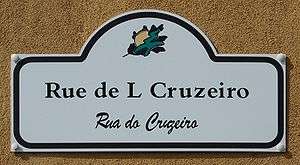
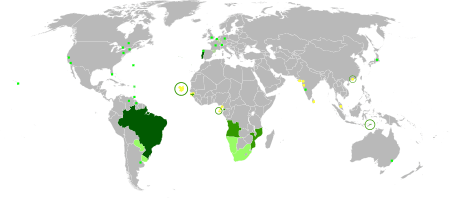
Portuguese is the official language of Portugal. Portuguese is a Romance language that originated in what is now Galicia and Northern Portugal, originating from Galician-Portuguese, which was the common language of the Galician and Portuguese people until the independence of Portugal. Particularly in the North of Portugal, there are still many similarities between the Galician culture and the Portuguese culture. Galicia is a consultative observer of the Community of Portuguese Language Countries. According to the Ethnologue of Languages, Portuguese and Spanish have a lexical similarity of 89% - educated speakers of each language can communicate easily with one another.
The Portuguese language is derived from the Latin spoken by the romanized Pre-Roman peoples of the Iberian Peninsula around 2000 years ago—particularly the Celts, Tartessians, Lusitanians and Iberians. In the 15th and 16th centuries, the language spread worldwide as Portugal established a colonial and commercial empire between 1415 and 1999.[121] Portuguese is now spoken as a native language in five different continents, with Brazil accounting for the largest number of native Portuguese speakers of any country (200 million speakers in 2012).[122]
In 2013 the Portuguese language is the official language spoken in Brazil, Angola, Mozambique, Cape Verde, São Tomé and Príncipe, Guinea-Bissau, Equatorial Guinea, and East Timor. These countries, plus Macau Special Administrative Region (People's Republic of China) where Portuguese is co-official with Cantonese, make up the Lusosphere, a term derived from the ancient Roman province of "Lusitania", which currently matches the Portuguese territory south of the Douro river.[123]
Mirandese is also recognized as a co-official regional language in some municipalities of North-Eastern Portugal. An estimate of between 6,000 and 7,000 Mirandese speakers has been documented for Portugal.[124]
According to International English Proficiency Index, Portugal has a high proficiency level in English, proficiency higher than in countries like Italy, France or Greece.
Education

.jpg)
The educational system is divided into preschool (for those under age 6), basic education (9 years, in three stages, compulsory), secondary education (3 years, compulsory since 2010), and higher education (subdivided in university and polytechnic education).
The total adult literacy rate is 99 percent. Portuguese primary school enrollments are close to 100 percent. According to the OECD's Programme for International Student Assessment (PISA) 2009, the average Portuguese 15-year-old student, when rated in terms of reading literacy, mathematics and science knowledge, is placed at the same level as those students from the United States, Sweden, Germany, Ireland, France, Denmark, United Kingdom, Hungary and Taipei, with 489 points (493 is the average).[125]
Over 35% of college-age citizens (20 years old) attend one of Portugal's higher education institutions[126] (compared with 50% in the United States and 35% in the OECD countries). In addition to being a destination for international students, Portugal is also among the top places of origin for international students. All higher education students, both domestic and international, totaled 380,937 in 2005.
Portuguese universities have existed since 1290. The oldest Portuguese university was first established in Lisbon before moving to Coimbra. Historically, within the scope of the Portuguese Empire, the Portuguese founded the oldest engineering school of the Americas (the Real Academia de Artilharia, Fortificação e Desenho of Rio de Janeiro) in 1792, as well as the oldest medical college in Asia (the Escola Médico-Cirúrgica of Goa) in 1842. The largest university in Portugal is the University of Lisbon.
Universities are usually organized into faculties. Institutes and schools are also common designations for autonomous subdivisions of Portuguese higher education institutions.
The Bologna process has been adopted, since 2006, by Portuguese universities and poly-technical institutes. Higher education in state-run educational establishments is provided on a competitive basis, a system of numerus clausus is enforced through a national database on student admissions. However, every higher education institution offers also a number of additional vacant places through other extraordinary admission processes for sportsmen, mature applicants (over 23 years old), international students, foreign students from the Lusosphere, degree owners from other institutions, students from other institutions (academic transfer), former students (readmission), and course change, which are subject to specific standards and regulations set by each institution or course department.
Most student costs are supported with public money. However, with the increasing tuition fees a student has to pay to attend a Portuguese state-run higher education institution and the attraction of new types of students (many as part-time students or in evening classes) like employees, businessmen, parents, and pensioners, many departments make a substantial profit from every additional student enrolled in courses, with benefits for the college or university's gross tuition revenue and without loss of educational quality (teacher per student, computer per student, classroom size per student, etc.).
Portugal has entered into cooperation agreements with the Massachusetts Institute of Technology and other US institutions to further develop and increase the effectiveness of Portuguese higher education and research.
Health
According to the latest Human Development Report, the average life expectancy in 2015 was 81.0 years.[127]
Portugal ranks 12th in the best public health systems in the world, ahead of high developed countries like the United Kingdom, Germany or Sweden.[128]
The Portuguese health system is characterized by three coexisting systems: the National Health Service (Serviço Nacional de Saúde', SNS), special social health insurance schemes for certain professions (health subsystems) and voluntary private health insurance. The SNS provides universal coverage. In addition, about 25% of the population is covered by the health subsystems, 10% by private insurance schemes and another 7% by mutual funds.
The Ministry of Health is responsible for developing health policy as well as managing the SNS. Five regional health administrations are in charge of implementing the national health policy objectives, developing guidelines and protocols and supervising health care delivery. Decentralization efforts have aimed at shifting financial and management responsibility to the regional level. In practice, however, the autonomy of regional health administrations over budget setting and spending has been limited to primary care.
The SNS is predominantly funded through general taxation. Employer (including the state) and employee contributions represent the main funding sources of the health subsystems. In addition, direct payments by the patient and voluntary health insurance premiums account for a large proportion of funding.
Similar to the other Eur-A countries, most Portuguese die from noncommunicable diseases. Mortality from cardiovascular diseases (CVD) is higher than in the eurozone, but its two main components, ischaemic heart disease and cerebrovascular disease, display inverse trends compared with the Eur-A, with cerebrovascular disease being the single biggest killer in Portugal (17%). Portuguese people die 12% less often from cancer than in the Eur-A, but mortality is not declining as rapidly as in the Eur-A. Cancer is more frequent among children as well as among women younger than 44 years. Although lung cancer (slowly increasing among women) and breast cancer (decreasing rapidly) are scarcer, cancer of the cervix and the prostate are more frequent. Portugal has the highest mortality rate for diabetes in the Eur-A, with a sharp increase since the 1980s.
Portugal's infant mortality rate has dropped sharply since the late 1970s, when 24 of 1000 newborns died in the first year of life. It is now around 2 deaths per a 1000 newborns. This improvement was mainly due to the decrease in neonatal mortality, from 15.5 to 2.4 per 1000 live births.
People are usually well informed about their health status, the positive and negative effects of their behaviour on their health and their use of health care services. Yet their perceptions of their health can differ from what administrative and examination-based data show about levels of illness within populations. Thus, survey results based on self-reporting at the household level complement other data on health status and the use of services.
Only one third of adults rated their health as good or very good in Portugal (Kasmel et al., 2004). This is the lowest of the Eur-A countries reporting and reflects the relatively adverse situation of the country in terms of mortality and selected morbidity.[129]
Culture
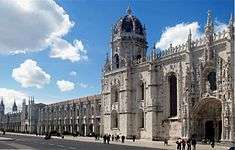
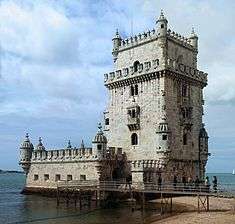
Portugal has developed a specific culture while being influenced by various civilizations that have crossed the Mediterranean and the European continent, or were introduced when it played an active role during the Age of Discovery. In the 1990s and 2000s (decade), Portugal modernized its public cultural facilities, in addition to the Calouste Gulbenkian Foundation established in 1956 in Lisbon.
These include the Belém Cultural Centre in Lisbon, Serralves Foundation and the Casa da Música, both in Porto, as well as new public cultural facilities like municipal libraries and concert halls that were built or renovated in many municipalities across the country. Portugal is home to fifteen UNESCO World Heritage Sites, ranking it 8th in Europe and 17th in the world.
Architecture
Traditional architecture is distinctive and include the Manueline, also known as Portuguese late Gothic, a sumptuous, composite Portuguese style of architectural ornamentation of the first decades of the 16th century. A 20th-century interpretation of traditional architecture, Soft Portuguese style, appears extensively in major cities, especially Lisbon. Modern Portugal has given the world renowned architects like Eduardo Souto de Moura, Álvaro Siza Vieira (both Pritzker Prize winners) and Gonçalo Byrne. In Portugal Tomás Taveira is also noteworthy, particularly for stadium design.[130][131][132]
Cinema
Portuguese cinema has a long tradition, reaching back to the birth of the medium in the late 19th century. Portuguese film directors such as Arthur Duarte, António Lopes Ribeiro, António Reis, Pedro Costa, Manoel de Oliveira, João César Monteiro, Edgar Pêra, António-Pedro Vasconcelos, Fernando Lopes, João Botelho and Leonel Vieira, are among those that gained notability. Noted Portuguese film actors include Joaquim de Almeida, Daniela Ruah, Maria de Medeiros, Diogo Infante, Soraia Chaves, Ribeirinho, Lúcia Moniz, and Diogo Morgado.
Literature

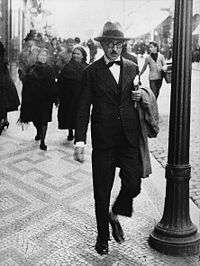
Portuguese literature, one of the earliest Western literatures, developed through text as well as song. Until 1350, the Portuguese-Galician troubadours spread their literary influence to most of the Iberian Peninsula.[133] Gil Vicente (c. 1465–c. 1536), was one of the founders of both Portuguese and Spanish dramatic traditions.
Adventurer and poet Luís de Camões (c. 1524–1580) wrote the epic poem "Os Lusíadas" (The Lusiads), with Virgil's Aeneid as his main influence.[134] Modern Portuguese poetry is rooted in neoclassic and contemporary styles, as exemplified by Fernando Pessoa (1888–1935). Modern Portuguese literature is represented by authors such as Almeida Garrett, Camilo Castelo Branco, Eça de Queiroz, Fernando Pessoa, Sophia de Mello Breyner Andresen, António Lobo Antunes and Miguel Torga. Particularly popular and distinguished is José Saramago, recipient of the 1998 Nobel Prize in Literature.
Cuisine
Portuguese cuisine is diverse. The Portuguese consume a lot of dry cod (bacalhau in Portuguese), for which there are hundreds of recipes.[135] There are more than enough bacalhau dishes for each day of the year. Two other popular fish recipes are grilled sardines and caldeirada, a potato-based stew that can be made from several types of fish. Typical Portuguese meat recipes, that may be made out of beef, pork, lamb, or chicken, include cozido à portuguesa, feijoada, frango de churrasco, leitão (roast suckling pig) and carne de porco à alentejana. A very popular northern dish is the arroz de sarrabulho (rice stewed in pigs blood) or the arroz de cabidela (rice and chickens meat stewed in chickens blood).
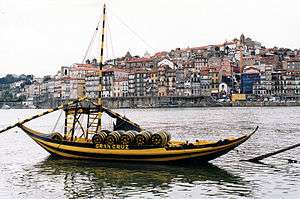
Typical fast food dishes include the Francesinha (Frenchie) from Porto, and bifanas (grilled pork) or prego (grilled beef) sandwiches, which are well known around the country. The Portuguese art of pastry has its origins in the many medieval Catholic monasteries spread widely across the country. These monasteries, using very few ingredients (mostly almonds, flour, eggs and some liquor), managed to create a spectacular wide range of different pastries, of which pastéis de Belém (or pastéis de nata) originally from Lisbon, and ovos moles from Aveiro are examples. Portuguese cuisine is very diverse, with different regions having their own traditional dishes. The Portuguese have a culture of good food, and throughout the country there are myriads of good restaurants and typical small tasquinhas.
Portuguese wines have enjoyed international recognition since the times of the Romans, who associated Portugal with their god Bacchus. Today, the country is known by wine lovers and its wines have won several international prizes. Some of the best Portuguese wines are: Vinho Verde, Vinho Alvarinho, Vinho do Douro, Vinho do Alentejo, Vinho do Dão, Vinho da Bairrada and the sweet: Port Wine, Madeira Wine, the Moscatel from Setúbal and Favaios. Port and Madeira are particularly appreciated in a wide range of places around the world.
Music

Portuguese music encompasses a wide variety of genres. The most renowned is Fado, a melancholy urban music originated in Lisbon, usually associated with the Portuguese guitar and saudade, or longing. Coimbra fado, a unique type of "serenading" fado, is also noteworthy. Internationally notable performers include Amália Rodrigues, Carlos Paredes, José Afonso, Mariza, Carlos do Carmo, António Chainho, Mísia, and Madredeus.
In addition to Fado and Folk, the Portuguese listen to pop and other types of modern music, particularly from North America and the United Kingdom, as well as a wide range of Portuguese, Caribbean and Brazilian artists and bands. Artists with international recognition include Dulce Pontes, Moonspell, Buraka Som Sistema, Blasted Mechanism and The Gift, with the two latter being nominees for a MTV Europe Music Award.
Portugal has several summer music festivals, such as Festival Sudoeste in Zambujeira do Mar, Festival de Paredes de Coura in Paredes de Coura, Festival Vilar de Mouros near Caminha, Boom Festival in Idanha-a-Nova Municipality, NOS Alive, Sumol Summer Fest in Ericeira, Rock in Rio Lisboa and Super Bock Super Rock in Greater Lisbon. Out of the summer season, Portugal has a large number of festivals, designed more to an urban audience, like Flowfest or Hip Hop Porto. Furthermore, one of the largest international Goa trance festivals takes place in central Portugal every two years, the Boom Festival, that is also the only festival in Portugal to win international awards: European Festival Award 2010 – Green'n'Clean Festival of the Year and the Greener Festival Award Outstanding 2008 and 2010. There is also the student festivals of Queima das Fitas are major events in a number of cities across Portugal. In 2005, Portugal held the MTV Europe Music Awards, in Pavilhão Atlântico, Lisbon.
In the classical music domain, Portugal is represented by names as the pianists Artur Pizarro, Maria João Pires, Sequeira Costa, the violinists Carlos Damas, Gerardo Ribeiro and in the past by the great cellist Guilhermina Suggia. Notable composers include José Vianna da Motta, Carlos Seixas, João Domingos Bomtempo, João de Sousa Carvalho, Luís de Freitas Branco and his student Joly Braga Santos, Fernando Lopes-Graça, Emmanuel Nunes and Sérgio Azevedo. Similarly, contemporary composers such as Nuno Malo and Miguel d'Oliveira have achieved some international success writing original music for film and television.
Visual arts
_-_Domingos_Sequeira.png)
Portugal has a rich history in painting. The first well-known painters date back to the 15th century – like Nuno Gonçalves – were part of the Gothic painting period. José Malhoa, known for his work Fado, and Columbano Bordalo Pinheiro (who painted the portraits of Teófilo Braga and Antero de Quental) were both references in naturalist painting.
The 20th century saw the arrival of Modernism, and along with it came the most prominent Portuguese painters: Amadeo de Souza-Cardoso, who was heavily influenced by French painters, particularly by the Delaunays. Among his best-known works is Canção Popular a Russa e o Fígaro. Another great modernist painters/writers were Carlos Botelho and Almada Negreiros, friend to the poet Fernando Pessoa, who painted his (Pessoa's) portrait. He was deeply influenced by both Cubist and Futurist trends.
Prominent international figures in visual arts nowadays include painters Vieira da Silva, Júlio Pomar, Helena Almeida, Joana Vasconcelos, Julião Sarmento and Paula Rego.
Sport

Football is the most popular sport in Portugal. There are several football competitions ranging from local amateur to world-class professional level. The legendary Eusébio is still a major symbol of Portuguese football history. FIFA World Player of the Year winners Luís Figo and Cristiano Ronaldo, who won the FIFA Ballon d'Or, are two world-class Portuguese football players. Portuguese football managers are also noteworthy, with José Mourinho and Fernando Santos are among the most renowned.
The Portugal national football team – Seleção Nacional – have won one UEFA European Championship title: the UEFA Euro 2016, with a 1–0 victory in the final over France, the tournament hosts. In addition, Portugal finished second in the Euro 2004 (held in Portugal), third in the 1966 FIFA World Cup, and fourth in the 2006 FIFA World Cup. At youth level, Portugal have won two FIFA World Youth Championships (in 1989 and 1991) and several UEFA European Youth Championships.
S.L. Benfica, Sporting CP and FC Porto are the largest sports clubs by popularity and by number of trophies won, often known as "os três grandes" ("the big three"). They have won eight titles in the European UEFA club competitions, were present in many finals and have been regular contenders in the last stages almost every season. Other than football, many Portuguese sports clubs, including the "big three", compete in several other sports events with a varying level of success and popularity, these may include roller hockey, basketball, futsal, handball, and volleyball. The Portuguese Football Federation (FPF) – Federação Portuguesa de Futebol – annually hosts the Algarve Cup, a prestigious women`s football tournament that has been celebrated in the Algarvian part of Portugal.
The Portuguese national rugby union team qualified for the 2007 Rugby World Cup and the Portuguese national rugby sevens team has played in the World Rugby Sevens Series.

In athletics, the Portuguese have won a number of gold, silver and bronze medals in the European, World and Olympic Games competitions. Cycling, with Volta a Portugal being the most important race, is also a popular sports event and include professional cycling teams such as Sporting CP, Boavista, Clube de Ciclismo de Tavira and União Ciclista da Maia.
The country has also achieved notable performances in sports like fencing, judo, kitesurf, rowing, sailing, surfing, shooting, triathlon and windsurf, owning several European and world titles. The paralympic athletes have also conquered many medals in sports like swimming, boccia and wrestling.
In motorsport, Portugal is internationally noted for the Rally of Portugal, and the Estoril, Algarve Circuits and the revived Porto Street Circuit which holds a stage of the WTCC every two years, as well as for a number of internationally noted pilots in varied motorsports.
In equestrian sports, Portugal won the only Horseball-Pato World Championship (in 2006), achieved the third position in the First Horseball World Cup (organized in Ponte de Lima, Portugal, in 2008), and has achieved several victories in the European Working Equitation Championship.
In water sports, Portugal has two major sports: swimming and water polo. Northern Portugal has its own original martial art, Jogo do Pau, in which the fighters use staffs to confront one or several opponents. Other popular sport-related recreational outdoor activities with thousands of enthusiasts nationwide include airsoft, fishing, golf, hiking, hunting and orienteering.
Portugal is one of the world's best golf destinations. It has received several awards by the World Golf Awards. Its weather allows play all year round.
See also
Notes
- ↑ In recognized minority languages of Portugal:
- Mirandese: Republica Pertuesa
References
- Sources
- ↑ (Portuguese) Público. "Portugal tem 92.212 quilómetros quadrados, por enquanto...". Retrieved 2 July 2012. Archived 5 October 2012 at the Wayback Machine.
- ↑ (Portuguese) . Accessed on 17 June 2015.
- ↑ (Portuguese) Portugal. Censos 2011 (ine.pt)
- 1 2 3 4 "Portugal". International Monetary Fund. Retrieved 13 December 2015.
- ↑ "Gini coefficient of equivalised disposable income (source: SILC)". Eurostat Data Explorer. Retrieved 13 August 2013.
- ↑ "2015 Human Development Report" (PDF). United Nations Development Programme. 2015. Retrieved 14 December 2015.
- ↑ "Reconhecimento oficial de direitos linguísticos da comunidade mirandesa (Official recognition of linguistic rights of the Mirandese community)". Centro de Linguística da Universidade de Lisboa. Retrieved 2 December 2015.
- ↑ The Euromosaic study, Mirandese in Portugal, europa.eu – European Commission website. Retrieved January 2007. Link updated December 2015
- ↑ Brian Jenkins, Spyros A. Sofos, Nation and identity in contemporary Europe, p. 145, Routledge, 1996, ISBN 0-415-12313-5
- ↑ Melvin Eugene Page, Penny M. Sonnenburg, p. 481
- ↑ "First global empire". Guinnessworldrecords.com. Retrieved 18 April 2014.
- ↑ "What was the Portuguese Empire?". Empires.findthedata.org. Retrieved 18 April 2014.
- ↑ "The World Factbook". cia.gov. Retrieved 14 September 2015.
- ↑ "ASIANOW - Macau's handover to China ends Portuguese era - December 17, 1999". cnn.com. Retrieved 14 September 2015.
- ↑ 2014 Global Report. (Europe 2014)
- ↑ Deloitte Social Progress 2015
- ↑ Numbeo QOLR
- ↑ "Vision of Humanity". Institute for Economics and Peace. Retrieved 9 June 2016.
- 1 2 "Constituição da República Portuguesa - D.R.E. (Constitution of the Portuguese Republic)" (in Portuguese). Diário da República Electrónico. 2 April 1976. Retrieved 16 August 2013.
- ↑ Morais, Carlos Blanco de (2011). A Constituição Revista — Parte III Constituição da República Portuguesa: Semipresidencialismo "on probation?" (PDF) (in Portuguese). Lisboa, Portugal: Fundação Francisco Manuel dos Santos. pp. 65–71. ISBN 978-989-8424-28-0. Retrieved 16 August 2013.
- ↑ Araújo, António; Morais, Carlos Blanco de; Cunha, Luís Campos e; Costa, José Manuel M. Cardoso da; Lobo, Marina Costa; Duarte, David; Duarte, Tiago; Freire, André; Garoupa, Nuno; Gonçalves, Maria Eduarda; Lomba, Pedro; Magalhães, Pedro; Brito, Miguel Nogueira de; Barros, Pedro Pita; Sousa, Luís de; Tavares, José A.; Vasconcelos Vilaça, Guilherme; Veiga, Francisco José; Andrade, José Carlos Vieira de (2011). Garoupa, Nuno; Magalhães, Pedro; Maduro, Miguel Poiares; Tavares, José A., eds. A Constituição Revista (PDF) (in Portuguese). Lisboa, Portugal: Fundação Francisco Manuel dos Santos. p. 143. ISBN 978-989-8424-28-0. Archived from the original (PDF) on 21 September 2013. Retrieved 16 August 2013.
- ↑ Veser, Ernst (1997). Semi-Presidentialism-Duverger's Concept — A New Political System Model (PDF) (in English and Chinese). Department of Education, School of Education, University of Cologne. pp. 39–60. Retrieved 20 August 2013.
- ↑ Shugart, Matthew Søberg (December 2005). "Semi-Presidential Systems: Dual Executive And Mixed Authority Patterns" (PDF). Palgrave Macmillan. Palgrave Macmillan Journals. 3 (3): 323–351. doi:10.1057/palgrave.fp.8200087. Retrieved 22 February 2015.
- ↑ The Social Progress Imperative. "Social Progress Index". socialprogressimperative.org. Retrieved 14 September 2015.
- ↑ Milhazes, José. Os antepassados caucasianos dos portugueses – Rádio e Televisão de Portugal in Portuguese. Archived 1 January 2016 at the Wayback Machine.
- 1 2 David Birmingham (2003), p.11
- ↑ David Rohrbacher, "Orosius," in The Historians of Late Antiquity (Routledge, 2002), pp. 135–137. Rohrbacher bases the date of birth on Augustine's description of Orosius as a "young priest" and a "son by age" in the period 414–418, which would place his age at 30 or younger.
- ↑ "Fim do Império Romano e Chegada dos Suevos". notapositiva.com (in Portuguese). Retrieved 12 March 2016.
- ↑ "Suevos". infoescola.com (in Portuguese). Retrieved 12 March 2016.
- ↑ "Vestígios da presença sueva no noroeste da península ibérica: na etnologia, na arqueologia e na língua". scielo.mec.pt (in Portuguese). Retrieved 12 March 2016.
- ↑ Portugal musulman (Le) – VIIIe-XIIIe siècles par Christophe Picard – Maisonneuve et Larose – Collection Occident Musulman – 2001, 500 p., 34 euros. ISBN 2706813989
- ↑ A History of Portugal and the Portuguese Empire, Vol. 1: From Beginnings to 1807: Portugal (Volume 1) p.55
- 1 2 H. V. Livermore, A New History of Portugal (Cambridge University Press: London, 1969) pp. 32-33.
- 1 2 3 Ribeiro, Ângelo; Hermano, José (2004). História de Portugal I — A Formação do Território [History of Portugal: The Formation of the Territory] (in Portuguese). QuidNovi. ISBN 989-554-106-6.
- ↑ Black Death, Great Moments in Science, ABC Science
- ↑ "The Portuguese Explorers: Newfoundland and Labrador Heritage". Heritage.nf.ca. Retrieved 31 January 2014.
- ↑ Vigneras, L.-A. (1979) [1966]. "Corte-Real, Miguel". In Brown, George Williams. Dictionary of Canadian Biography. I (1000–1700) (online ed.). University of Toronto Press.
- ↑ "Town of Portugal Cove - St.Philip's : History". pcsp.ca. Retrieved 14 September 2015.
- ↑ The standard view of historians is that Cabral was blown off course as he was navigating the currents of the South Atlantic, sighted the coast of South America, thereby accidentally discovering Brazil. However, for an alternative account of the discovery of Brazil, see History of Brazil
- ↑ Giles Tremlett (22 March 2007). "Another nail in Cook's coffin as map suggests he was pipped by Portugal | World news". The Guardian. Retrieved 31 January 2014.
- ↑ Debusmann, Bernd (15 January 2014). "Kangaroo in 400-year-old manuscript could change Australian history". London: Telegraph. Retrieved 31 January 2014.
- ↑ Perry, Michael (21 March 2007). "Map proves Portuguese discovered Australia: new book". Reuters. Retrieved 31 January 2014.
- ↑ Saint and Nation. Books.google.com. 30 April 2011. p. 10. ISBN 9780271037738. Retrieved 18 August 2012.
- ↑ Peña,Lorenzo. Un puente jurídico entre Iberoamérica y Europa:la Constitución española de 1812. Instituto de Filosofía del CSIC
The first thing there is to understand is that in a good measure, the Courts of Cádiz created a new state, the Spanish state.[...]there had never been a proclamation of a Kingdom of Spain, so that difficulties always arose upon the legal value of the very frequent references to 'Spain' in the legal texts of the sixteenth, seventeenth and eighteenth centuries. The Spanish sovereigns had always refused the advice [...] in the sense of establishing a United Kingdom of Spain, preferring to see themselves as vertices of converging scattered kingdoms, at least in theory. Even the Napoleonic Bayonne Constitution of 1808 did not proclaim a kingdom of Spain, but a 'Crown of Spain and the Indies'. On the other hand, 'Spain' was merely a geographical name, a simple romance version of 'Hispania',whereby its use, in principle, should not have to go beyond the designations ‘Galia’,‘Germania’[...]
- ↑ "IBGE teen". Ibge.gov.br. Archived from the original on 25 January 2012. Retrieved 11 February 2012.
- ↑ "Historical Depictions of the 1755 Lisbon Earthquake". Nisee.berkeley.edu. 12 November 1998. Retrieved 6 May 2012.
- ↑ Kenneth Maxwell, Pombal, Paradox of the Enlightenment (Cambridge: Cambridge University Press, 1995), 83, 91–108, 160–62.
- ↑ P S Lele, Dadra and Nagar Haveli: past and present, Published by Usha P. Lele, 1987,
- ↑ "Portugal Não É Um País Pequeno". Purl.pt. Archived from the original on 14 May 2011. Retrieved 21 February 2011.
- ↑ Flight from Angola, The Economist (16 August 1975).
- ↑ Dismantling the Portuguese Empire, Time Magazine (Monday, 7 July 1975).
- ↑ "Climate of the World: Portugal - Weather UK - weatheronline.co.uk". weatheronline.co.uk. Retrieved 14 September 2015.
- ↑ Instituto Português do Mar e da Atmosfera (2012). "Extremos climáticos de temperatura, Capitais Distrito" (in Portuguese). Instituto Português do Mar e da Atmosfera. Retrieved 23 January 2013.
- ↑ "Instituto Português do Mar e da Atmosfera, IP Portugal". ipma.pt. Retrieved 22 August 2010.
- ↑ Brian Vastag 5 Years After: Portugal's Drug Decriminalization Policy Shows Positive Results. Scientific American. 7 April 2009
- ↑ Maia Szalavitz, Drugs in Portugal: Did Decriminalization Work?, Time (26 April 2009)
- ↑ Greenwald, Glenn (2 April 2009). "Drug Decriminalization in Portugal: Lessons for Creating Fair and Successful Drug Policies" (pdf). Cato Institute. Retrieved 14 February 2015.
- ↑ "Diário da República, 1.ª série — N.º 105 — 31 de Maio de 2010" (PDF). Retrieved 14 September 2013.
- ↑ "Districts of Portugal". Distritosdeportugal.com. Retrieved 22 August 2010.
- 1 2 "Portugal’s Debt Efforts May Be Warning for Greece", New York Times, 14 February 2012.
- ↑ "Portugal 2011 deficit to beat goal on one-off revs-PM". Reuters UK. 13 December 2011. Retrieved 30 December 2011.
- ↑ Kowsmann, Patricia, "Portugal govt ends golden-share holdings" (Paid content), Dow Jones Newswires 5 July 2011.
- ↑ "Portugal Government Ends Golden-Share Holdings". The Wall Street Journal. 5 July 2011. Retrieved 20 July 2011.
- ↑ Institute of Management Technology Nagpur: "Eurocrisis", Okonomist, Vol.1, Issue 3, January 2012
- 1 2 "Portugal seeks market access with $5 bln bond exchange". Kathimerini (English Edition). 3 October 2012. Retrieved 17 October 2012.
- ↑ "Dívida pública revista em alta para 127,8% do PIB em 2013 (Valor supera previsões iniciais do Governo, da troika e do FMI.)" (in Portuguese). Lusa and Público. 30 September 2013. Retrieved 30 October 2013.
- ↑ (Portuguese) "O estado a que o Estado chegou" no 2.º lugar do top, Diário de Notícias (2 March 2011)
- ↑ (Portuguese) "O estado a que o Estado chegou" no 2.º lugar do top, Diário de Notícias (2 March 2012)
- ↑ BPN Oliveira Costa vendeu a Cavaco e filha 250 mil ações da SLN - Expresso.pt. Expresso.sapo.pt (13 April 2011). Retrieved on 26 July 2013.
- ↑ Oliveira Costa é vizinho de Cavaco no Algarve - Portugal - DN. Dn.pt. Retrieved on 26 July 2013.
- ↑ Dias Loureiro entre os dirigentes do PSD no processo-crime do BPN - JN. Jn.pt. Retrieved on 26 July 2013.
- ↑ "Eurostat GDP per capita 2003-2014 2009". Retrieved 13 August 2015.
- ↑ "Europe's Leading Golf Destination 2013 — World Travel Awards". Worldtravelawards.com. Retrieved 31 January 2014.
- ↑ "Algarve elected Europe's best Golf Destination of 2014". The Portugal News. 21 November 2013. Retrieved 31 January 2014.
- ↑ "História". SEDES (in Portuguese and English). SEDES. 2013. Retrieved 12 May 2013.
- ↑ Grande Enciclopédia Universal, p. 10543, "Portugal", para. 4
- ↑ "NVESTING IN PORTUGAL". The Financial Times. The Financial Times Ltd. 8 April 2008. Retrieved 11 May 2013.
- ↑ "Portugal follows Ireland out of bailout programme". Europe Sun. Retrieved 18 May 2014.
- ↑ "No Slide Title" (PDF). Retrieved 31 January 2014.
- ↑ http://www.economist.com/media/pdf/QUALITY_OF_LIFE.pdf
- ↑ "Portugueses perderam poder de compra entre 2005 e 2007 e estão na cauda da Zona Euro" (in Portuguese). Público. 11 December 2008. Retrieved 10 October 2010.
- ↑ Pessoa, M.F.; Mendes, B.; Oliveria, J.S. "Per Capita Consumption" (PDF).
Annual per capita consumption of fish and shellfish for human food.
- ↑ Agência Lusa (2011). "Covilhã: Aleia vai montar avião até agora vendido em kit e jactos portugueses em 2011". Noticias (in Portuguese). Produzido por PTC. Retrieved 12 May 2013.
- ↑ Diário Digital / Lusa (22 August 2008). "Évora aprova isenções fiscais aos projectos da Embraer". Dinheiro (in Portuguese). Retrieved 12 May 2013.
- ↑ Portugal: Financial System Stability Assessment, including Reports on the Observance of Standards and Codes on the following topics: Banking Supervision, Securities Regulation, and Insurance Regulation, IMF, (October 2006)
- ↑ "Travel and Tourism in Portugal". Euromonitor International. Euromonitor. September 2012. Retrieved 12 May 2013.
- ↑ World's Top Tourism Destinations (absolute numbers). Data as collected by World Tourism Organization (UNWTO) for TMT 2005 Edition
- ↑ "Best European Country Winners: 2014 10Best Readers' Choice Travel Awards". 10Best. Retrieved 14 September 2015.
- ↑ "Go Lisbon Blog » Blog Archive » Lisbon Slowly Rising as One of Europe's Most-Visited Cities". Golisbon.com. 30 May 2013. Retrieved 31 January 2014.
- ↑ DN Online, ed. (25 January 2007). "Cidades atraem mais turistas do que os destinos sol e mar" (in Portuguese). Lisbon, Portugal: Diário das Noticias. Retrieved 30 April 2011.
- ↑ "Cultural traditions in Portugal, Uganda and Ukraine added to UNESCO heritage protection list".
- ↑ "Ciência Viva". Cienciaviva.pt. Retrieved 22 August 2010.
- ↑ "Tecparques – Associação Portuguesa de Parques de Ciência e Tecnologia". Tecparques.pt. Archived from the original on 28 April 2011. Retrieved 22 August 2010.
- ↑ "Madeira Tecnopolo". Madeiratecnopolo.pt. Retrieved 22 August 2010.
- ↑ "Sines Tecnopolo". Sines Tecnopolo. Retrieved 22 August 2010.
- ↑ "TECMAIA Parque de Ciência e Tecnologia da Maia". Tecmaia.com.pt. Retrieved 2 July 2011.
- ↑ "Parque de Ciência e Tecnologia da Covilhã (Parkurbis)". Parkurbis.pt. Retrieved 22 August 2010.
- ↑ Portugal ganha terreno no ranking da inovação, Público (1 February 2011)
- ↑ "ListAfterList.com". ListAfterList.com. Retrieved 22 August 2010.
- ↑ "Curious? Read". Curiousread.com. February 2008. Retrieved 22 August 2010.
- ↑ "IEA Energy Statistics: Portugal". International Energy Agency. 2006. Retrieved 7 April 2009.
- ↑ Staff (8 April 2009). "Fontes renováveis originaram 43% da electricidade consumida". Diário Digital (in Portuguese). Retrieved 17 April 2009.
- ↑ Staff (8 June 2010). "Portugal já exportou mais electricidade este ano que em 2009". Agência Financeira (in Portuguese). Retrieved 8 June 2010.
- ↑ "Portugal". Jewishvirtuallibrary.org. Retrieved 6 May 2012.
- ↑ Bauchet, M; McEvoy, B; Pearson, LN; Quillen, EE; Sarkisian, T; Hovhannesyan, K; Deka, R; Bradley, DG; Shriver, MD (2007). "Measuring European Population Stratification with Microarray Genotype Data". American Journal of Human Genetics. 80 (5): 948–956. doi:10.1086/513477. PMC 1852743
 . PMID 17436249.
. PMID 17436249. - ↑ https://www.cia.gov/library/publications/the-world-factbook/rankorder/2127rank.html
- ↑ Live births outside of marriage, with parents co-habiting or not (%) in Portugal PORDATA
- ↑ "Fertility in Portugal: a Macro/Micro Economic Perspective / Projects funded by national science agencies / Projects / Research output / Welcome - CEFAGE". Cefage.uevora.pt. Retrieved 31 January 2014.
- ↑ See http://www.bertelsmann-stiftung.de/de/publikationen/publikation/did/social-justice-in-the-eu-index-report-2015/
- ↑ http://appsso.eurostat.ec.europa.eu/nui/show.do?dataset=urb_lpop1&lang=en
- ↑ Censos 2011, (Instituto Nacional de Estatística-19 July 2011)
- ↑ Source of the city populations: INE census, 2011.
- 1 2 Portugal – Emigration, Eric Solsten, ed. Portugal: A Country Study. Washington: GPO for the Library of Congress, 1993.
- ↑ "Portugal sees integration progress", BBC News, 14 November 2005
- ↑ ITDS, Rui Campos, Pedro Senos. "Statistics Portugal". Ine.pt. Retrieved 2 July 2011.
- ↑ A mais discriminada, (Expresso-5 April 2008)
- ↑ Brasileiros são a maior colónia estrangeira em Portugal Embaixada de Portugal No Brasil Archived 6 November 2013 at the Wayback Machine.
- ↑ "Census – Final results: Portugal – 2011". Statistics Portugal. 2012. p. 530. Retrieved 10 December 2012.
- ↑ "Instituto Nacional de Estatistica, Censos 2011". Censos.ine.pt. Retrieved 31 January 2014.
- ↑ "Número de católicos portugueses tem vindo a diminuir >". TVI24. 16 April 2012. Retrieved 31 January 2014.
- ↑ "History of the Portuguese". portugueselanguage.net. Retrieved 14 September 2015.
- ↑ "Report: Portuguese is the third most used language on Facebook – Socialbakers". Portuguese American Journal. Portuguese American Journal. 18 November 2012. Retrieved 11 November 2013.
- ↑ "Dictionary of Greek and Roman Geography (1854), LABANAE AQUAE, LUSITA´NIA". tufts.edu. Retrieved 14 September 2015.
- ↑ "List of Languages". languagesindanger.eu. Retrieved 14 September 2015.
- ↑ "Alunos portugueses pela primeira vez "perto da média" – relatório PISA" (in Portuguese). Destak.
- ↑ "Um Contrato de confiança no Ensino Superior para o futuro de Portugal" (in Portuguese). Government of Portugal, portugal.gov.pt. 11 January 2010. Archived from the original on 24 July 2011.
- ↑ List of countries by life expectancy
- ↑ World Health Organization ranking of health systems in 2000
- ↑ Highlights on health in Portugal 2004 at the Wayback Machine (archived 1 December 2009). World Health Organization
- ↑ (Portuguese) Estádios de Tomás Taveira e Souto Moura premiados, Diário de Notícias (8 July 2005)
- ↑ Tomás Taveira, Geoffrey Broadbent (introduction), Publisher: St Martins Pr (February 1991)
- ↑ (Portuguese) Tomás Tveira desenha estádio do Palmeiras no Brasil, Diarioeconomico.com
- ↑ Poesia e Prosa Medievais, p. 9, para. 4
- ↑ "The Lusiads". World Digital Library. 1800–1882. Retrieved 31 August 2013.
- ↑ SILVA, A. J. M. (2015), The fable of the cod and the promised sea. About portuguese traditions of bacalhau, in BARATA, F. T- and ROCHA, J. M. (eds.), Heritages and Memories from the Sea, Proceedings of the 1st International Conference of the UNESCO Chair in Intangible Heritage and Traditional Know-How: Linking Heritage, 14–16 January 2015. University of Evora, Évora, pp. 130-143. PDF version
- Bibliography
- Bliss, Christopher; Macedo, Jorge Braga de (1990). Unity with Diversity in the European Economy: the Community's Southern Frontier. London, England: Centre for Economic Policy Research. ISBN 978-0-521-39520-5.
- Juang, Richard M.; Morrissette, Noelle Anne (2008). Africa and the Americas: Culture, Politics, and History: A Multidisciplinary Encyclopedia. 2. ISBN 978-1-85109-441-7.
- Page, Melvin Eugene; Sonnenburg, Penny M. (2003). Colonialism: An International, Social, Cultural, and Political Encyclopedia. 2. ISBN 978-1-57607-335-3.
- Brockey, Liam Matthew (2008). Portuguese Colonial Cities in the Early Modern World. ISBN 978-0-7546-6313-3.
- Ribeiro, Ângelo; José Hermano (2004). História de Portugal I — A Formação do Território [History of Portugal: The Formation of the Territory] (in Portuguese). QuidNovi. ISBN 989-554-106-6.
- Ribeiro, Ângelo; Saraiva, José Hermano (2004). História de Portugal II — A Afirmação do País [History of Portugal II: An Affirmation of Nation] (in Portuguese). QuidNovi. ISBN 989-554-107-4.
- de Macedo, Newton; Saraiva, José Hermano (2004). História de Portugal III — A Epopeia dos Descobrimentos [History of Portugal III: The Epoch of Discoveries] (in Portuguese). QuidNovi. ISBN 989-554-108-2.
- de Macedo, Newton; Saraiva, José Hermano (2004). História de Portugal IV — Glória e Declínio do Império [History of Portugal IV: Glory and Decline of Empire] (in Portuguese). QuidNovi. ISBN 989-554-109-0.
- de Macedo, Newton; Saraiva, José Hermano (2004). História de Portugal V — A Restauração da Indepêndencia [History of Portugal IV: The Restoration of Independence] (in Portuguese). QuidNovi. ISBN 989-554-110-4.
- Saraiva, José Hermano (2004). História de Portugal X — A Terceira República [History of Portugal X: The Third Republic] (in Portuguese). QuidNovi. ISBN 989-554-115-5.
- Loução, Paulo Alexandre (2000). Portugal, Terra de Mistérios [Portugal: Land of Mysteries] (in Portuguese) (3rd ed.). Ésquilo. ISBN 972-8605-04-8.
- Muñoz, Mauricio Pasto (2003). Viriato, A Luta pela Liberdade [Viriato: The Struggle for Liberty] (in Portuguese) (3rd ed.). Ésquilo. ISBN 972-8605-23-4.
- Grande Enciclopédia Universal. Durclub. 2004.
- Constituição da República Portuguesa [Constitution of the Portuguese Republic] (in Portuguese) (VI Revisão Constitucional ed.). 2004.
External links
| Wikimedia Commons has media related to Portugal. |
- News about Portugal from the Portuguese American Journal
- "Portugal". The World Factbook. Central Intelligence Agency.
- Portugal at UCB Libraries GovPubs
- Portugal at DMOZ
- Portugal profile from the BBC News
- National English language newspaper
-
 Wikimedia Atlas of Portugal
Wikimedia Atlas of Portugal -
 Geographic data related to Portugal at OpenStreetMap
Geographic data related to Portugal at OpenStreetMap - National Wine Website
- Portuguese Pamphlets Collection From the Rare Book and Special Collections Division at the Library of Congress
- Government
- Official Portuguese Government website (English) / (Portuguese)
- Official Parliament website
- Trade
- Travel
- Official Travel and Tourism office website
- Official Portuguese Government Travel/media website
- Official Portuguese Golf Travel/media website
 |
Atlantic Ocean | |
|
 |
| Atlantic Ocean | |
| ||
| ||||
| | ||||
| Atlantic Ocean | Atlantic Ocean | |
Coordinates: 38°42′N 9°11′W / 38.700°N 9.183°W

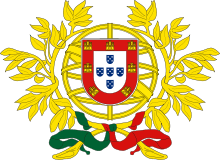
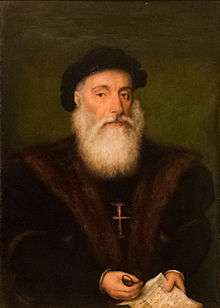
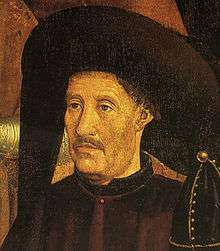


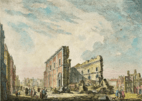







.jpg)


.jpg)

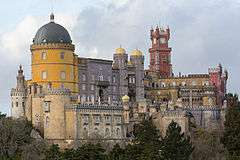

.jpg)

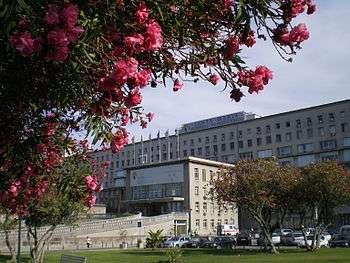
.svg.png)
